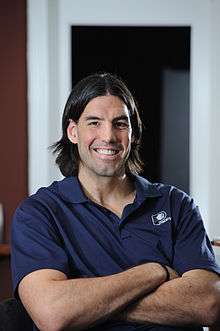Buenos Aires
| Autonomous City of Buenos Aires | |||
|---|---|---|---|
| Ciudad Autónoma de Buenos Aires | |||
|
From top, left to right: panoramic view of the central business district, the Palace of the Argentine National Congress, Puente de la Mujer in Puerto Madero, tango dancers in San Telmo, Casa Rosada, the Metropolitan Cathedral, the Cabildo, the Obelisco, the Teatro Colón, La Recoleta Cemetery, the Planetario within the Palermo Woods, and Caminito in La Boca. | |||
| |||
|
Nickname(s): The Queen of El Plata (La reina del Plata), The City of Fury (La Ciudad de la Furia) , BA | |||
 Autonomous City of Buenos Aires Location in Argentina | |||
| Coordinates: 34°36′12″S 58°22′54″W / 34.60333°S 58.38167°WCoordinates: 34°36′12″S 58°22′54″W / 34.60333°S 58.38167°W | |||
| Country |
| ||
| Established |
2 February 1536 (by Pedro de Mendoza) 11 June 1580 (by Juan de Garay) | ||
| Government | |||
| • Type | Autonomous city | ||
| • Body | City Legislature | ||
| • Chief of Government | Horacio Rodríguez Larreta | ||
| • Senators | Federico Pinedo, Marta Varela, Pino Solanas | ||
| Area | |||
| • City | 203 km2 (78 sq mi) | ||
| • Land | 203 km2 (78.5 sq mi) | ||
| • Water | ? km2 (? sq mi) ?% | ||
| • Urban | ? km2 (? sq mi) | ||
| • Metro | 4,758 km2 (1,837 sq mi) | ||
| Elevation | 25 m (82 ft) | ||
| Population (2010 census)[1] | |||
| • City | 2,890,151 | ||
| • Rank | 1st | ||
| • Density | 14,000/km2 (37,000/sq mi) | ||
| • Metro | 12,741,364[1] | ||
| Demonym(s) | porteño (m), porteña (f) | ||
| Time zone | ART (UTC−3) | ||
| Area code(s) | 011 | ||
| HDI (2011) | 0.889 Very High[2] | ||
| Website |
www | ||
Buenos Aires (/ˌbweɪnəs ˈɛəriːz/ or /-ˈaɪrɪs/;[3] Spanish pronunciation: [ˈbwenos ˈai̯ɾes]) is the capital and most populous city of Argentina. The city is located on the western shore of the estuary of the Río de la Plata, on the South American continent's southeastern coast. "Buenos aires" can be translated as "fair winds" or "good airs", but the first one was the meaning intended by the founders in the 16th century, by the use of the original name "Real de Nuestra Señora Santa María del Buen Ayre". The Greater Buenos Aires conurbation, which also includes several Buenos Aires Province districts, constitutes the fourth-most populous metropolitan area in the Americas, with a population of around 17 million.[1]
The city of Buenos Aires is neither part of Buenos Aires Province nor the Province's capital; rather, it is an autonomous district.[4] In 1880, after decades of political infighting, Buenos Aires was federalized and removed from Buenos Aires Province.[5] The city limits were enlarged to include the towns of Belgrano and Flores; both are now neighborhoods of the city. The 1994 constitutional amendment granted the city autonomy, hence its formal name: Ciudad Autónoma de Buenos Aires (Autonomous City of Buenos Aires). Its citizens first elected a chief of government (i.e. mayor) in 1996; before, the mayor was directly appointed by the President of the Republic.
Buenos Aires is considered an 'alpha city' by the study GaWC5.[6] Buenos Aires' quality of life was ranked 81st in the world and one of the best in Latin America in 2012, with its per capita income among the three highest in the region.[7][8] It is the most visited city in South America and the 2nd-most visited city of Latin America (behind Mexico City[9]).
Buenos Aires is a top tourist destination,[10] and is known for its preserved Spanish/European-style architecture[11] and rich cultural life.[12] Buenos Aires held the 1st Pan American Games in 1951 as well as hosting two venues in the 1978 FIFA World Cup. Buenos Aires will host the 2018 Summer Youth Olympics[13] and the 2018 G20 summit.[14]
Buenos Aires is a multicultural city, being home to multiple ethnic and religious groups. Several languages are spoken in the city in addition to Spanish, contributing to its culture and the dialect spoken in the city and in some other parts of the country. This is because in the last 150 years the city, and the country in general, has been a major recipient of millions of immigrants from all over the world, making it a melting pot where several ethnic groups live together and being considered as one of the most diverse cities of Latin America.[15]
Etymology
.jpg)
It is recorded under the archives of Aragonese that Catalan missionaries and Jesuits arriving in Cagliari (Sardinia) under the Spanish Crown, after its capture from the Pisans in 1324 established their headquarters on top of a hill that overlooked the city.[16] The hill was known to them as Buen Ayre (or "Bonaria" in Sardinian language), as it was free of the foul smell prevalent in the old city (the castle area), which is adjacent to swampland. During the siege of Cagliari, the Aragonese built a sanctuary to the Virgin Mary on top of the hill. In 1335, King Alfonso the Gentle donated the church to the Mercedarians, who built an abbey that stands to this day. In the years after that, a story circulated, claiming that a statue of the Virgin Mary was retrieved from the sea after it miraculously helped to calm a storm in the Mediterranean Sea. The statue was placed in the abbey. Spanish sailors, especially Andalusians, venerated this image and frequently invoked the "Fair Winds" to aid them in their navigation and prevent shipwrecks. A sanctuary to the Virgin of Buen Ayre would be later erected in Seville.[16]
In the first foundation of Buenos Aires, Spanish sailors arrived thankfully in the River de la Plata by the blessings of the "Santa Maria de los Buenos Aires", the "Holy Virgin Mary of the Good Winds" who was said to have given them the good winds to reach the coast of what is today the modern city of Buenos Aires.[17] Pedro de Mendoza called the city "Holy Mary of the Fair Winds", a name suggested by the chaplain of Mendoza's expedition – a devotee of the Virgin of Buen Ayre – after the Sardinian "Madonna de Bonaria"[18] (that is still to this day the patroness of Sardinia[19]). Mendoza’s settlement soon came under attack by indigenous people, and was abandoned in 1541.[17]
For many years, the name was attributed to a Sancho del Campo, who is said to have exclaimed: How fair are the winds of this land!, as he arrived. But Eduardo Madero, in 1882 after conducting extensive research in Spanish archives, ultimately concluded that the name was indeed closely linked with the devotion of the sailors to Our Lady of Buen Ayre.[20]
A second (and permanent) settlement was established in 1580 by Juan de Garay, who sailed down the Paraná River from Asunción (now the capital of Paraguay). Garay preserved the name originally chosen by Mendoza, calling the city Ciudad de la Santísima Trinidad y Puerto de Santa María del Buen Aire ("City of the Most Holy Trinity and Port of Saint Mary of the Fair Winds"). The short form "Buenos Aires" became the common usage during the 17th century.[21]
The usual abbreviation for Buenos Aires in Spanish is Bs.As.[22] It is common as well to refer to it as "B.A." or "BA" /ˌbiːˈeɪ/ bee-AY).[23]
While "BA" is used more by expats residing in the city, the locals more often use the abbreviation "Baires", in one word.
History
Colonial times

Seaman Juan Díaz de Solís, navigating in the name of Spain, was the first European to reach the Río de la Plata in 1516. His expedition was cut short when he was killed during an attack by the native Charrúa tribe in what is now Uruguay.
The city of Buenos Aires was first established as Ciudad de Nuestra Señora Santa María del Buen Ayre[24] (literally "City of Our Lady Saint Mary of the Fair Winds") after Our Lady of Bonaria (Patroness Saint of Sardinia) on 2 February 1536 by a Spanish expedition led by Pedro de Mendoza. The settlement founded by Mendoza was located in what is today the San Telmo district of Buenos Aires, south of the city center.
More attacks by the indigenous people forced the settlers away, and in 1542 the site was abandoned.[25][26] A second (and permanent) settlement was established in 11 June 1580 by Juan de Garay, who arrived by sailing down the Paraná River from Asunción (now the capital of Paraguay). He dubbed the settlement "Santísima Trinidad" and its port became "Puerto de Santa María de los Buenos Aires."[21]
From its earliest days, Buenos Aires depended primarily on trade. During most of the 17th and 18th centuries, Spanish ships were menaced by pirates, so they developed a complex system where ships with military protection were dispatched to Central America, cross the land, from there to Lima, Peru and from it to the inner cities of the viceroyalty. Because of this, products took a very long time to arrive in Buenos Aires, and the taxes generated by the transport made them prohibitive. This scheme frustrated the traders of Buenos Aires, and a thriving contraband industry developed. This also instilled a deep resentment in porteños towards the Spanish authorities.[24]
Sensing these feelings, Charles III of Spain progressively eased the trade restrictions and finally declared Buenos Aires an open port in the late 18th century. The capture of Porto Bello by British forces also fueled the need to foster commerce via the Atlantic route, to the detriment of Lima-based trade. One of his rulings was to split a region from the Viceroyalty of Perú and create instead the Viceroyalty of the Río de la Plata, with Buenos Aires as the capital. However, Charles's placating actions did not have the desired effect, and the porteños, some of them versed in the ideology of the French Revolution, became even more convinced of the need for independence from Spain.
War of independence
.jpg)
During the British invasions of the Río de la Plata, British forces attacked Buenos Aires twice. In 1806 the British successfully invaded Buenos Aires, but an army from Montevideo led by Santiago de Liniers defeated them. In the brief period of British rule, the viceroy Rafael Sobremonte managed to escape to Córdoba and designated this city as capital. Buenos Aires became the capital again after its liberation, but Sobremonte could not resume his duties as viceroy. Santiago de Liniers, chosen as new viceroy, prepared the city against a possible new British attack and repelled the attempted invasion of 1807. The militarization generated in society changed the balance of power favorably for the criollos (in contrast to peninsulars), as well as the development of the Peninsular War in Spain. An attempt by the peninsular merchant Martín de Álzaga to remove Liniers and replace him with a Junta was defeated by the criollo armies. However, by 1810 it would be those same armies who would support a new revolutionary attempt, successfully removing the new viceroy Baltasar Hidalgo de Cisneros. This is known as the May Revolution, which is now celebrated as a national holiday. This event started the Argentine War of Independence, and many armies left Buenos Aires to fight the diverse strongholds of royalist resistance, with varying levels of success. The government was held first by two Juntas of many members, then by two triumvirates, and finally by a unipersonal office, the Supreme Director. Formal independence from Spain was declared in 1816, at the Congress of Tucumán. Buenos Aires managed to endure the whole Spanish American wars of independence without falling again under royalist rule.
Historically, Buenos Aires has been Argentina's main venue for liberal, free-trade and foreign ideas, while many of the provinces, especially to the north-west, advocated a more nationalistic and Catholic approach to political and social issues. Much of the internal tension in Argentina's history, starting with the centralist-federalist conflicts of the 19th century, can be traced back to these contrasting views. In the months immediately following 25 May Revolution, Buenos Aires sent a number of military envoys to the provinces with the intention of obtaining their approval. Many of these missions ended in violent clashes, and the enterprise fuelled tensions between the capital and the provinces.
In the 19th century the city was blockaded twice by naval forces: by the French from 1838 to 1840, and later by an Anglo-French expedition from 1845 to 1848. Both blockades failed to force the city into submission, and the foreign powers eventually desisted from their demands.
Modern history
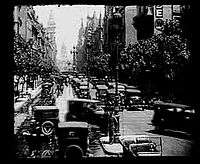
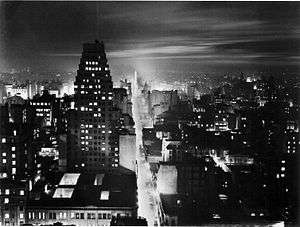
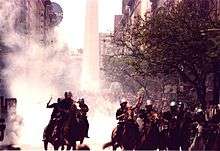
During most of the 19th century, the political status of the city remained a sensitive subject. It was already capital of Buenos Aires Province, and between 1853 and 1860 it was the capital of the seceded State of Buenos Aires. The issue was fought out more than once on the battlefield, until the matter was finally settled in 1880 when the city was federalized and became the seat of government, with its mayor appointed by the president. The Casa Rosada became the seat of the president.[21]
Health conditions in poor areas were negative, with high rates of tuberculosis. Public-health physicians and politicians typically blamed both the poor themselves and their ramshackle tenement houses (conventillos) for the spread of the dreaded disease. People ignored public-health campaigns to limit the spread of contagious diseases, such as the prohibition of spitting on the streets, the strict guidelines to care for infants and young children, and quarantines that separated families from ill loved ones.[27]
In addition to the wealth generated by the Buenos Aires Customs and the fertile pampas, railroad development in the second half of the 19th century increased the economic power of Buenos Aires as raw materials flowed into its factories. A leading destination for immigrants from Europe, particularly Italy and Spain, from 1880 to 1930 Buenos Aires became a multicultural city that ranked itself with the major European capitals. The Colón Theater became one of the world's top opera venues, and the city became the regional capital of radio, television, cinema, and theatre. The city's main avenues were built during those years, and the dawn of the 20th century saw the construction of South America's then-tallest buildings and the first underground system. A second construction boom from 1945 to 1980 reshaped downtown and much of the city.
Buenos Aires also attracted migrants from Argentina's provinces and neighboring countries. Shanty towns (villas miseria) started growing around the city's industrial areas during the 1930s, leading to pervasive social problems and social contrasts with the largely upwardly mobile Buenos Aires population. These laborers became the political base of Peronism, which emerged in Buenos Aires during the pivotal demonstration of 17 October 1945, at the Plaza de Mayo.[28] Industrial workers of the Greater Buenos Aires industrial belt have been Peronism's main support base ever since, and Plaza de Mayo became the site for demonstrations and many of the country's political events; on 16 June 1955, however, a splinter faction of the Navy bombed the Plaza de Mayo area, killing 364 civilians (see Bombing of Plaza de Mayo). This was the only time the city was attacked from the air, and the event was followed by a military uprising which deposed President Perón, three months later (see Revolución Libertadora).
In the 1970s the city suffered from the fighting between left-wing revolutionary movements (Montoneros, E.R.P. and F.A.R.) and the right-wing paramilitary group Triple A, supported by Isabel Perón, who became president of Argentina in 1974 after Juan Perón's death.
The March 1976 coup, led by General Jorge Videla, only escalated this conflict; the "Dirty War" resulted in 30,000 desaparecidos (people kidnapped and killed by the military during the years of the junta).[29] The silent marches of their mothers (Mothers of the Plaza de Mayo) are a well-known image of Argentines suffering during those times.
The dictatorship's appointed mayor, Osvaldo Cacciatore, also drew up plans for a network of freeways intended to relieve the city's acute traffic gridlock. The plan, however, called for a seemingly indiscriminate razing of residential areas and, though only three of the eight planned were put up at the time, they were mostly obtrusive raised freeways that continue to blight a number of formerly comfortable neighborhoods to this day.
The city was visited by Pope John Paul II twice: in 1982, and a second visit in 1987, which gathered some of the largest crowds in the city's history. The return of democracy in 1983 coincided with a cultural revival, and the 1990s saw an economic revival, particularly in the construction and financial sectors.
On 17 March 1992 a bomb exploded in the Israeli Embassy, killing 29 and injuring 242. Another explosion, on 18 July 1994 destroyed a building housing several Jewish organizations, killing 85 and injuring many more, these incidents marked the beginning of Middle Eastern terrorism to South America.
Following a 1993 agreement, the Argentine Constitution was amended to give Buenos Aires autonomy and rescinding, among other things, the president's right to appoint the city's mayor (as had been the case since 1880). On 30 June 1996, voters in Buenos Aires chose their first elected mayor (Chief of Government).
On 30 December 2004, a fire at the República Cromagnon nightclub killed almost 200 people. The nightclub fire was one of the greatest non-natural tragedies in Argentine history.
On 22 February 2012, a train crashed at Once Station. Fifty-one people were killed and more than 700 were injured.[30] The dead and seriously injured were in the first two carriages,[31] which were packed with people who had moved to the front of the train to be near the station exit on arrival.
Government and politics
Government structure
.jpg)
The Executive is held by the Chief of Government (Spanish: Jefe de Gobierno), elected for a four-year term together with a Deputy Chief of Government, who presides over the 60-member Buenos Aires City Legislature. Each member of the Legislature is elected for a four-year term; half of the legislature is renewed every two years. Elections use the D'Hondt method of proportional representation. The Judicial branch is composed of the Supreme Court of Justice (Tribunal Superior de Justicia), the Magistrate's Council (Consejo de la Magistratura), the Public Ministry, and other City Courts. The Article 61 of the 1996 Constitution of the City of Buenos Aires states that "Suffrage is free, equal, secret, universal, compulsory and non-accumulative. Resident aliens enjoy this same right, with its corresponding obligations, on equal terms with Argentine citizens registered in the district, under the terms established by law."[32]
Legally, the city has less autonomy than the Provinces. In June 1996, shortly before the City's first Executive elections were held, the Argentine National Congress issued the National Law 24.588 (known as Ley Cafiero, after the Senator who advanced the projemacct) by which the authority over the 25,000-strong Argentine Federal Police and the responsibility over the federal institutions residing at the City (e.g., National Supreme Court of Justice buildings) would not be transferred from the National Government to the Autonomous City Government until a new consensus could be reached at the National Congress. Furthermore, it declared that the Port of Buenos Aires, along with some other places, would remain under constituted federal authorities.[33] As of 2011, the deployment of the Metropolitan Police of Buenos Aires is ongoing.[34]
Beginning in 2007, the city has embarked on a new decentralization scheme, creating new Communes (comunas) which are to be managed by elected committees of seven members each.
Recent political history
.jpg)
In 1996, following the 1994 reform of the Argentine Constitution, the city held its first mayoral elections under the new statutes, with the mayor's title formally changed to "Head of Government". The winner was Fernando de la Rúa, who would later become President of Argentina from 1999 to 2001.
De la Rúa's successor, Aníbal Ibarra, won two popular elections, but was impeached (and ultimately deposed on 6 March 2006) as a result of the fire at the República Cromagnon nightclub. Jorge Telerman, who had been the acting mayor, was invested with the office. In the 2007 elections, Mauricio Macri of the Republican Proposal (PRO) party won the second-round of voting over Daniel Filmus of the Frente para la Victoria (FPV) party, taking office on 9 December 2007. In 2011, the elections went to a second round with 60.96% of the vote for PRO, compared to 39.04% for FPV, thus re-electing Macri as mayor of the city with María Eugenia Vidal as deputy mayor.[35]
The 2015 elections were the first to use an electronic voting system in the city, similar to the one used in Salta Province.[36] In these elections held on 5 July 2015, Macri stepped down as mayor and pursue his presidential bid and Horacio Rodríguez Larreta took his place as the mayoral candidate for PRO. In the first round of voting, FPV's Mariano Recalde obtained 21.78% of the vote, while Martín Lousteau of the ECO party obtained 25.59% and Larreta obtained 45.55%, meaning that the elections went to a second round since PRO was unable to secure the majority required for victory.[37] The second round was held on 19 July 2015 and Larreta obtained 51.6% of the vote, followed closely by Lousteau with 48.4%, thus PRO won the elections for a third term with Larreta as mayor and Diego Santilli as deputy. In these elections, PRO was stronger in the wealthier neighbourhoods of northern Buenos Aires, while ECO was stronger in the south of the city.[38]
National representation
Buenos Aires is represented in the Argentine Senate by three senators (as of 2016, Federico Pinedo, Marta Varela and Pino Solanas).[39] The people of Buenos Aires also elect 25 national deputies to the Argentine Chamber of Deputies.
Demographics
Census data
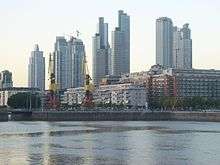
In the census of 2010 there were 2,891,082 people residing in the city.[41] The population of Greater Buenos Aires was 13,147,638 according to 2010 census data.[42] The population density in Buenos Aires proper was 13,680 inhabitants per square kilometer (34,800 per mi2), but only about 2,400 per km2 (6,100 per mi2) in the suburbs.
The population of Buenos Aires proper has hovered around 3 million since 1947, due to low birth rates and a slow migration to the suburbs. The surrounding districts have, however, expanded over fivefold (to around 10 million) since then.[41]
The 2001 census showed a relatively aged population: with 17% under the age of fifteen and 22% over sixty, the people of Buenos Aires have an age structure similar to those in most European cities. They are older than Argentines as a whole (of whom 28% were under 15, and 14% over 60).[43]
Two-thirds of the city's residents live in apartment buildings and 30% in single-family homes; 4% live in sub-standard housing.[44] Measured in terms of income, the city's poverty rate was 8.4% in 2007 and, including the metro area, 20.6%.[45] Other studies estimate that 4 million people in the metropolitan Buenos Aires area live in poverty.[46]
The city's resident labor force of 1.2 million in 2001 was mostly employed in the services sector, particularly social services (25%), commerce and tourism (20%) and business and financial services (17%); despite the city's role as Argentina's capital, public administration employed only 6%. Manufacturing still employed 10%.[44]
Districts
The city is divided into barrios (neighborhoods) for administrative purposes, a division originally based on Catholic parroquias (parishes).[47] A common expression is that of the Cien barrios porteños ("One hundred porteño neighborhoods"), referring to a composition made popular in the 1940s by tango singer Alberto Castillo; however, Buenos Aires only consists of 48 official barrios. There are a several subdivisions of these districts, some with a long history and others that are the product of a real estate invention. A notable example is Palermo — the city's largest district — which has been subdivided into various barrios, including Palermo Soho, Palermo Hollywood, Las Cañitas and Palermo Viejo, among others. A newer scheme has divided the city into 15 comunas (communes).[48]
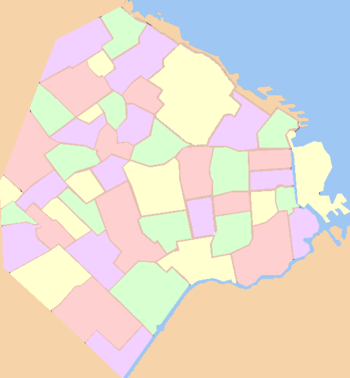
|
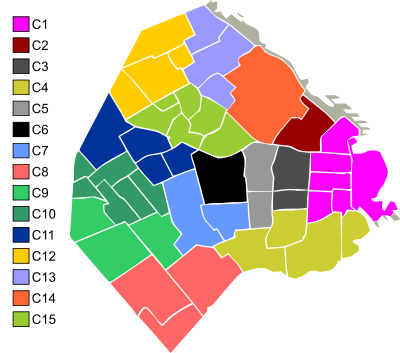 |
Population origin

The majority of porteños have European origins, mostly from the Calabrian, Ligurian, Piedmont, Lombardy, Sicily and Campania regions of Italy and from the Andalusian, Galician, Asturian, and Basque regions of Spain.[49][50] Unrestricted waves of European immigrants to Argentina starting in the mid-19th century significantly increased the country's population, even causing the number of porteños to triple between 1887 and 1915 from 500,000 to 1.5 million.[51]
Other significant European origins include German, Scottish, Norwegian, Polish, French, Portuguese, Swedish, Greek, Czech, Croatian, Dutch, Russian, Serbian, English, Hungarian and Bulgarian. In the 1980s and 1990s, there was a small wave of immigration from Romania and Ukraine.[52] There is a minority of criollo citizens, dating back to the Spanish colonial days. The Criollo and Spanish-aboriginal (mestizo) population in the city has increased mostly as a result of immigration from the inner provinces and from other countries such as neighboring Bolivia, Paraguay, Chile and Peru, since the second half of the 20th century .
The Jewish community in Greater Buenos Aires numbers around 250,000, and is the largest in Latin America. Most are of Northern, Western, Central, and Eastern European Ashkenazi origin, primarily Swedish, Dutch, Polish, German, and Russian Jews, with a significant Sephardic minority, mostly made up of Syrian Jews and Lebanese Jews.[53] Important Lebanese, Georgians, Syrian and Armenian communities have had a significant presence in commerce and civic life since the beginning of the 20th century.
Most East Asian immigration in Buenos Aires comes from China. Chinese immigration is the fourth largest in Argentina, with the vast majority of them living in Buenos Aires and its metropolitan area.[54] In the 1980s, most of them were from Taiwan, but since the 1990s the majority of Chinese immigrants come from the continental province of Fujian.[54] The mainland Chinese who came from Fujian mainly installed supermarkets throughout the city and the suburbs; these supermarkets are so common that, in average, there is one every two and a half blocks and are simply referred to as el chino ("the Chinese").[54][55] Japanese immigrants are mostly from the Okinawa Prefecture. They started the dry cleaning business in Argentina, an activity that is considered idiosyncratic to the Japanese immigrants in Buenos Aires.[56] Korean Immigration occurred after the division of Korea; they mainly settled in Flores and Once.[57]
In the 2010 census [INDEC], 2.1% of the population or 61,876 persons declared to be Amerindian or first-generation descendants of Amerindians in Buenos Aires (not including the 24 adjacent Partidos that make up Greater Buenos Aires).[58] Amongst the 61,876 persons who are of indigenous origin, 15.9% are Quechua people, 15.9% are Guaraní, 15.5% are Aymara and 11% are Mapuche.[58] Within the 24 adjacent Partidos, 186,640 persons or 1.9% of the total population declared themselves to be Amerindian.[58] Amongst the 186,640 persons who are of indigenous origin, 21.2% are Guaraní, 19% are Toba, 11.3% are Mapuche, 10.5% are Quechua and 7.6% are Diaguita.[58]
In the city, 15,764 people identified themselves as Afro-Argentine in the 2010 Census.[59]
Religion
According to a 2008 CONICET survey on creeds, Christianity is the most prevalently practiced religion in Buenos Aires (79.6%), and most inhabitants are Roman Catholic (70%),[60] though studies in recent decades found that fewer than 20% are practicing.[61] Buenos Aires is the seat of a Roman Catholic metropolitan archbishop (the Catholic primate of Argentina), currently Archbishop Mario Poli. His predecessor, Cardinal Jorge Bergoglio, was elected to the Papacy as Pope Francis on 13 March 2013. There are Protestant, Orthodox Christian, Muslim, Jewish, Jehovah's Witnesses, Mormon, and Buddhist minorities. The city is home to the largest mosque in South America.[62] Also, irreligion in Buenos Aires is higher than in other parts of the country, with about a 18.0% of the porteños declaring themselves as either atheist or agnostic.[60]
Urban problems
Villas miserias range from small groups of precarious houses to larger, more organised communities with thousands of residents. In rural areas, the houses in the villas miserias might be made of mud and wood. Villas miseria are found around and inside the large cities of Buenos Aires, Rosario, Córdoba and Mendoza, among others. The villas draw people from several backgrounds. Some are local citizens who have fallen from an already precarious economic position. In most cases, a villa miseria is populated by the children and grandchildren of the original settlers, who have been unable to improve their economic status.
Buenos Aires has below 2 m2 (22 sq ft) of green space per person, which is ten times less than New York, seven times less than Madrid and five times less than Paris. The World Health Organization (WHO), in its concern for public health, produced a document stating that every city should have a minimum of 9 m2 (97 sq ft) of green space per person. An optimal amount would sit between 10 and 15 m2 (161 sq ft) per person.[63][64]
Geography


The limits of Buenos Aires proper are determined in the eastern part and north-east by the Rio de la Plata, in the southern part and southeast by the Riachuelo and to the northwest, west and Southwest by General Paz Avenue, a 24 km (15 mi) long highway that separates the province of Buenos Aires from the 203 km2 (78 sq mi) that form the city.
The city of Buenos Aires lies in the pampa region, except for some zones like the Buenos Aires Ecological Reserve, the Boca Juniors (football) Club "sports city", Jorge Newbery Airport, the Puerto Madero neighborhood and the main port itself; these were all built on reclaimed land along the coasts of the Rio de la Plata (the world's widest river).[65][66][67]
The region was formerly crossed by different creeks and lagoons, some of which were refilled and others tubed. Among the most important creeks are Maldonado, Vega, Medrano, Cildañez and White. In 1908 many creeks were channelled and rectified, as floods were damaging the city's infrastructure. Starting in 1919, most creeks were enclosed. Notably, the Maldonado was tubed in 1954, and runs below Juan B. Justo Avenue.
Climate
Buenos Aires has a humid subtropical climate (Köppen Cfa), with hot and humid summers and mild winters.[68] The warmest month is January, with a daily average of 25.1 °C (77.2 °F). Most days see temperatures in the 28 to 31 °C (82 to 88 °F) with nights between 16 to 21 °C (61 to 70 °F). Heat waves from Brazil can push temperatures above 35 °C (95 °F), yet the city is subject to cold fronts that bring short periods of pleasant weather and crisp nights. Relative humidity is 64–70% in the summer, so the heat index is higher than the true air temperature. The highest temperature ever recorded was 43.3 °C (110 °F) on 29 January 1957.[69] Spring (September to middle December) and autumn (middle March to middle June) are generally mild and volatile, with averages temperatures of around 17 °C (63 °F) and frequent thunderstorms, especially during the spring.
Winters are temperate, though suburban areas often experience frost from May to August, as opposed to downtown Buenos Aires, which experiences the phenomenon only some times per season caused by the Urban Heat phenomenon. Relative humidity averages in the upper 70s%, which means the city is noted for its moderate to heavy fogs during autumn and winter.[70] July is the coolest month, with an average temperature of 10.9 °C (51.6 °F). Cold spells originating from Antarctica occur almost every year, and combined with the high wintertime humidity, conditions in winter may feel much cooler than the measured temperature. Most days peak reach 12 to 20 °C (54 to 68 °F) and drop to 3 to 8 °C (37 to 46 °F) at night. Southerly winds may keep temperatures below 10 °C (50 °F) for a few days, whereas northerly winds may bring temperatures above 20 °C (68 °F) for a few days; these variations are normal.
The lowest temperature ever recorded in central Buenos Aires (Buenos Aires Central Observatory) was −5.4 °C (22 °F) on 9 July 1918.[71] Snow is very rare in the city: the last snowfall occurred on 9 July 2007 when, during the coldest winter in Argentina in almost 30 years, severe snowfalls and blizzards hit the country. It was the first major snowfall in the city in 89 years.[72][73] On 17 July 2010, in the midst of another cold winter, flurries struck the southern reaches of Buenos Aires, but not the central parts as occurred in 2007 or 1918.
Spring is very windy and variable: there may be heat waves with temperatures of 35 °C (95 °F) even in early October. Severe thunderstorms are likely between September and December.
The city receives 1,214.6 mm (48 in) of rainfall per year.[74] Rain can be expected at any time of year and hailstorms are not unusual.
| Climate data for Buenos Aires Central Observatory (2001–2010) | |||||||||||||
|---|---|---|---|---|---|---|---|---|---|---|---|---|---|
| Month | Jan | Feb | Mar | Apr | May | Jun | Jul | Aug | Sep | Oct | Nov | Dec | Year |
| Average high °C (°F) | 30.4 (86.7) |
29.0 (84.2) |
26.8 (80.2) |
23.4 (74.1) |
19.3 (66.7) |
16.6 (61.9) |
16.0 (60.8) |
17.7 (63.9) |
19.6 (67.3) |
23.1 (73.6) |
26.1 (79) |
28.5 (83.3) |
23.0 (73.4) |
| Daily mean °C (°F) | 25.1 (77.2) |
23.9 (75) |
22.0 (71.6) |
18.0 (64.4) |
14.4 (57.9) |
11.9 (53.4) |
11.4 (52.5) |
12.8 (55) |
14.8 (58.6) |
18.2 (64.8) |
20.9 (69.6) |
23.2 (73.8) |
18.1 (64.6) |
| Average low °C (°F) | 20.2 (68.4) |
19.5 (67.1) |
18.0 (64.4) |
13.6 (56.5) |
10.5 (50.9) |
8.3 (46.9) |
7.7 (45.9) |
8.7 (47.7) |
10.6 (51.1) |
13.5 (56.3) |
16.0 (60.8) |
18.2 (64.8) |
13.7 (56.7) |
| Average precipitation mm (inches) | 167.5 (6.594) |
171.0 (6.732) |
172.3 (6.783) |
110.8 (4.362) |
72.3 (2.846) |
54.8 (2.157) |
70.0 (2.756) |
71.7 (2.823) |
75.0 (2.953) |
124.4 (4.898) |
114.1 (4.492) |
102.4 (4.031) |
1,306.3 (51.429) |
| Average precipitation days | 9.5 | 9.0 | 10.0 | 7.9 | 6.6 | 7.1 | 8.0 | 7.7 | 7.9 | 9.9 | 9.9 | 9.1 | 102.6 |
| Average relative humidity (%) | 65 | 70 | 72 | 77 | 78 | 79 | 79 | 74 | 71 | 69 | 68 | 64 | 72 |
| Mean monthly sunshine hours | 275.9 | 217.5 | 210.8 | 183.0 | 167.4 | 144.0 | 148.8 | 167.4 | 180.0 | 220.1 | 252.0 | 272.8 | 2,439.7 |
| Mean daily sunshine hours | 8.9 | 7.7 | 6.8 | 6.1 | 5.4 | 4.8 | 4.8 | 5.4 | 6.0 | 7.1 | 8.4 | 8.8 | 6.68 |
| Source #1: University of Buenos Aires[75] | |||||||||||||
| Source #2: Servicio Meteorológico Nacional (humidity 1981–1990)[74] | |||||||||||||
Economy
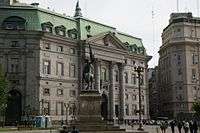

Buenos Aires is the financial, industrial, and commercial hub of Argentina. The economy in the city proper alone, measured by Gross Geographic Product (adjusted for purchasing power), totaled US$84.7 billion (US$34,200 per capita) in 2011[76] and amounts to nearly a quarter of Argentina's as a whole.[77] Metro Buenos Aires, according to one well-quoted study, constitutes the 13th largest economy among the world's cities.[78] The Buenos Aires Human Development Index (0.923 in 1998) is likewise high by international standards.[79]
Port
The port of Buenos Aires is one of the busiest in South America; navigable rivers by way of the Rio de la Plata connect the port to north-east Argentina, Brazil, Uruguay and Paraguay. As a result, it serves as the distribution hub for a vast area of the south-eastern region of the continent. The Port of Buenos Aires handles over 11 million revenue tons annually,[80] and Dock Sud, just south of the city proper, handles another 17 million metric tons.[81] Tax collection related to the port has caused many political problems in the past, including a conflict in 2008 that led to protests and a strike in the agricultural sector after the government raised export tariffs.[82]
Services
The city's services sector is diversified and well-developed by international standards, and accounts for 76% of its economy (compared to 59% for all of Argentina's).[83] Advertising, in particular, plays a prominent role in the export of services at home and abroad. The financial and real-estate services sector is the largest, however, and contributes to 31% of the city's economy. Finance (about a third of this) in Buenos Aires is especially important to Argentina's banking system, accounting for nearly half the nation's bank deposits and lending.[83] Nearly 300 hotels and another 300 hostels and bed & breakfasts are licensed for Tourism in Buenos Aires, and nearly half the rooms available were in four-star establishments or higher.[84]
Manufacturing
Manufacturing is, nevertheless, still prominent in the city's economy (16%) and, concentrated mainly in the southern part of the city. It benefits as much from high local purchasing power and a large local supply of skilled labor as it does from its relationship to massive agriculture and industry just outside the city limits. Construction activity in Buenos Aires has historically been among the most accurate indicators of national economic fortunes (see table at right), and since 2006 around 3 million square metres (32 million square feet) of construction has been authorized annually.[83] Meat, dairy, grain, tobacco, wool and leather products are processed or manufactured in the Buenos Aires metro area. Other leading industries are automobile manufacturing, oil refining, metalworking, machine building and the production of textiles, chemicals, clothing and beverages.
Government finances
The city's budget, per Mayor Macri's 2011 proposal, will include US$6 billion in revenues and US$6.3 billion in expenditures. The city relies on local income and capital gains taxes for 61% of its revenues, while federal revenue sharing will contribute 11%, property taxes, 9%, and vehicle taxes, 6%. Other revenues include user fees, fines and gambling duties. The city devotes 26% of its budget to education, 22% for health, 17% for public services and infrastructure, 16% for social welfare and culture, 12% in administrative costs and 4% for law enforcement. Buenos Aires maintains low debt levels and its service requires less than 3% of the budget.[85]
Culture

Strongly influenced by European culture, Buenos Aires is sometimes referred to as the "Paris of South America".[24][89] The city has the busiest live theatre industry in Latin America, with scores of theaters and productions.[90] In fact, every weekend, there are about 300 active theatres with plays, a number that places the city as 1st worldwide, more than either London, New York or Paris, cultural Meccas in themselves. The number of cultural festivals with more than 10 sites and 5 years of existence also places the city as 2nd worldwide, after Edinburgh.[91]
Buenos Aires is the site of the Teatro Colón, an internationally rated opera house.[92] There are several symphony orchestras and choral societies. The city has numerous museums related to history, fine arts, modern arts, decorative arts, popular arts, sacred art, arts and crafts, theatre and popular music, as well as the preserved homes of noted art collectors, writers, composers and artists. The city is home to hundreds of bookstores, public libraries and cultural associations (it is sometimes called "the city of books"), as well as the largest concentration of active theatres in Latin America. It has a world-famous zoo and botanical garden, a large number of landscaped parks and squares, as well as churches and places of worship of many denominations, many of which are architecturally noteworthy.[92]
Art
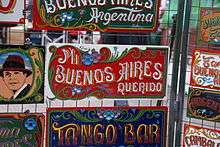
Buenos Aires has a thriving arts culture,[94] with "a huge inventory of museums, ranging from obscure to world-class."[95] The barrios of Palermo and Recoleta are the city's traditional bastions in the diffusion of art, although in recent years there has been a tendency of appearance of exhibition venues in other districts such as Puerto Madero or La Boca; renowned venues include MALBA, the National Museum of Fine Arts, Fundación Proa, Faena Arts Center, and the Usina del Arte.[96] Other popular institutions are the Buenos Aires Museum of Modern Art, the Quinquela Martín Museum, the Evita Museum, the Fernández Blanco Museum, the José Hernández Museum, and the Palais de Glace, among others.[97] A traditional event that occurs once a year is La Noche de los Museos ("Night of the Museums"), when the city's museums, universities, and artistic spaces open their doors for free until early morning; it usually takes place in November.[98][99]
Buenos Aires has been the birthplace of several artists and movements of national and international relevance, and has become a central motif in Argentine artistic production, specially since the 20th century.[100] Examples include: the Paris Group - so named for being influenced by the School of Paris - constituted by Antonio Berni, Aquiles Badi, Lino Enea Spilimbergo, Raquel Forner and Alfredo Bigatti, among others; and [101] the La Boca artists - including Benito Quinquela Martín and Alfredo Lazzari, among others - who mostly came from Italy or were of Italian descent, and usually painted scenes from this working-class port neighbourhood.[102] During the 1960s, the Torcuato di Tella Institute - located in Florida Street - became a leading local center for pop art, performance art, installation art, experimental theatre, and conceptual art; this generation of artists included Marta Minujín, Dalila Puzzovio, David Lamelas and Clorindo Testa.
Buenos Aires has also become a prominent center of contemporary street art; its welcoming attitude has made it one of the world's top capitals of such expression.[103][104] The city's turbulent modern political history has "bred an intense sense of expression in porteños," and urban art has been used to depict these stories and as a means of protest.[94][104] However, not all of its street art concerns politics, it is also used as a symbol of democracy and freedom of expression.[94] Murals and graffiti are so common that they are considered "an everyday occurrence," and have become part of the urban landscape of barrios such as Palermo, Urquiza, Coghlan and San Telmo.[105] This has to do with the legality of such activities —provided that the building owner has consented—, and the receptiveness of local authorities, who even subsidize various works.[103] The abundance of places for urban artists to create their work, and the relatively lax rules for street art, have attracted international artists such as Blu, Jef Aérosol, Aryz, ROA, and Ron English.[103] Guided tours to see murals and graffiti around the city have been growing steadily.[106]
Literature
.jpg)
Despite its short urban history, Buenos Aires has an abundant literary production; its mythical-literary network "has grown at the same rate at which the streets of the city earned its shores to the pampas and buildings stretched its shadow on the curb."[107] The city has at least 734 bookstores, more per person than any other city in the world.[108] Gabriela Adamo, former president of the city's annual book fair, relates the popularity of reading among its inhabitants to the wave of mass immigration in the late 19th and early 20th centuries, which created "a multicultural environment in which culture and the arts thrived."[108] Publishing experts have also linked it to the city's obsession with psychoanalysis.[108] The city also ranks third in terms of secondhand bookshops per inhabitant, most of them congregated in Corrientes Avenue.[108] Arguably the most famous bookstore is El Ateneo Grand Splendid, a reformed theatre. The Guardian ranked it second in its list of "The world's 10 best bookshops" in 2008.[109]
The literary history of the country is strongly linked to Buenos Aires' cafés; some of the most important still exist, like Café Tortoni, Café La Biela, Esquina Homero Manzi, Confitería Las Violetas, Confitería London City and Confitería Hotel Castelar. The city hosts the National Library of the Argentine Republic, the largest library in the country. Every April, the Buenos Aires International Book Fair takes place, which describes itself as "the most important annual literary event in the Spanish speaking world."[110] Every year, it gathers more than one million visitors, and usually features the presence of prestigious international authors.
Language
Known as Rioplatense Spanish, Buenos Aires' Spanish (as that of other cities like Rosario and Montevideo, Uruguay) is characterised by voseo, yeísmo and aspiration of s in various contexts. It is heavily influenced by the dialects of Spanish spoken in Andalusia and Murcia. A phonetic study conducted by the Laboratory for Sensory Investigations of CONICET and the University of Toronto showed that the prosody of porteño is closer to the Neapolitan language of Italy than to any other spoken language.[111]
In the early 20th century, Argentina absorbed millions of immigrants, many of them Italians, who spoke mostly in their local dialects (mainly Neapolitan, Sicilian and Genoese). Their adoption of Spanish was gradual, creating a pidgin of Italian dialects and Spanish that was called cocoliche. Its usage declined around the 1950s.
Many Spanish immigrants were from Galicia, and Spaniards are still generically referred to in Argentina as gallegos (Galicians). Galician language, cuisine and culture had a major presence in the city for most of the 20th century. In recent years, descendants of Galician immigrants have led a mini-boom in Celtic music (which also highlighted the Welsh traditions of Patagonia).
Yiddish was commonly heard in Buenos Aires, especially in the Balvanera garment district and in Villa Crespo until the 1960s. Most of the newer immigrants learn Spanish quickly and assimilate into city life.
The Lunfardo argot originated within the prison population, and in time spread to all porteños. Lunfardo uses words from Italian dialects, from Brazilian Portuguese, from African and Caribbean languages and even from English. Lunfardo employs humorous tricks such as inverting the syllables within a word (vesre). Today, Lunfardo is mostly heard in tango lyrics;[112] the slang of the younger generations has been evolving away from it.
Music
 |
"Mi Buenos Aires querido"
"Mi Buenos Aires querido" ("My Beloved Buenos Aires"), a classic tango composition of 1934, sung by Carlos Gardel and written by Alfredo Le Pera. |
| Problems playing this file? See media help. | |
According to the Harvard Dictionary of Music, "Argentina has one of the richest art music traditions and perhaps the most active contemporary musical life" in South America.[113] Buenos Aires boasts of several professional orchestras, including the Argentine National Symphony Orchestra, the Ensamble Musical de Buenos Aires and the Camerata Bariloche; as well as various conservatories that offer professional music education, like the Conservatorio Nacional Superior de Música.[113] As a result of the growth and commercial prosperity of the city in the late 18th century, the theatre became a vital force in Argentine musical life, offering Italian and French operas and Spanish zarzuelas.[113] Italian music was very influential during the 19th century and the early 20th century, in part because of immigration, but operas and salon music were also composed by Argentines, including Francisco Hargreaves and Juan Gutiérrez.[113] A nationalist trend that drew from Argentine traditions, literature and folk music was an important force during the 19th century, including composers Alberto Williams, Julián Aguirre, Arturo Berutti and Felipe Boero.[113] In the 1930s, composers such as Juan Carlos Paz and Alberto Ginastera "began to espouse a cosmopolitan and modernist style, influenced by twelve-tone techniques and serialism"; while avant-garde music thrived by the 1960s, with the Rockefeller Foundation financing the Centro Interamericano de Altos Estudios Musicales, which brought internationally famous composers to work and teach in Buenos Aires, also establishing an electronic music studio.[113]
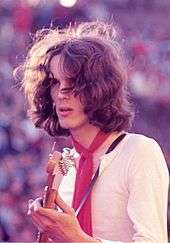
The Río de la Plata is known for being the birthplace of tango, which is considered an emblem of Buenos Aires.[114] The city considers itself the Tango World Capital, and as such hosts many related events, the most important being an annual festival and world tournament.[114] The most important exponent of the genre is Carlos Gardel, followed by Aníbal Troilo; other important composers include Alfredo Gobbi, Ástor Piazzolla, Osvaldo Pugliese, Mariano Mores, Juan D'Arienzo and Juan Carlos Cobián.[115] Tango music experienced a period of splendor during the 1940s, while in the 1960s and 1970s nuevo tango appeared, incorporating elements of classical and jazz music. A contemporary trend is neotango (also known as electrotango), with exponents such as Bajofondo and Gotan Project. On 30 September 2009, UNESCO's Intergovernmental Committee of Intangible Heritage declared tango part of the world's cultural heritage, making Argentina eligible to receive financial assistance in safeguarding tango for future generations.[116]
During the mid-1960s, Buenos Aires was also the birthplace of Argentine rock, one of the most important non-English language forms of this music in the world. A new generation of musicians from the legendary bar "la Cueva" in Avenida Pueyrredón, were trying to reflect an everyday reality absent in popular music since tango.[117] The movement was dubbed "progressive music" by the specialized press, and included Almendra, Los Gatos and Manal.[118] These bands were the pillars of not only what is known in Argentina as rock nacional ("national rock"),[117] but also rock en español as a whole.[119] The act of writing serious and artistics songs in Spanish was unprecedented, and established a rock identity in the country.[119] Since then, the style has evolved and diversified steadily throughout the years, encompassing most of its subgenres. Luis Alberto Spinetta, born in Buenos Aires in 1950, enjoyed universal critical acclaim that distinguished him as one of the most important artists from the Rio de la Plata.[120] Since 2014, "Musician's Day" is celebrated in Argentina on 23 January to commemorate his birth.[120]
A musical style that originated in the slums (locally, villas miseria) of Buenos Aires and its metropolitan area is cumbia villera, particularly popular among the lower classes of Argentina and its neighboring countries. It originated during the late 1990s, in the midst of an economic and social decline in Argentina.[121][122] It is characterized by basic, low-budget productions, and lyrics that focuse on crime, drugs, class conflict and police corruption, acting as a vehicle of expression for the marginal classes, describing the everyday life in which they are immersed. Because of its characteristics, cumbia villera has been compared to gangsta rap, protest song, punk rock and narcocorrido, among other styles.[121] A recent phenomenon is the appearance of "cumbia cheta" (cheto meaning "posh"), a derivative performed and listened by the middle and upper class, which distances itself from the political protest of the 1990s and 2000s.[123]
The city hosts several music festivals every year. A popular genre is electronic dance music, with festivals including Creamfields BA, SAMC, Moonpark, and a local edition of Ultra Music Festival. Other well-known events include the Buenos Aires Jazz Festival, Personal Fest, Quilmes Rock and Pepsi Music. Some music festivals are held in Greater Buenos Aires, like Lollapalooza, which takes place at the Hipódromo de San Isidro in San Isidro.
Cinema

Argentine cinema history began in Buenos Aires with the first film exhibition on 18 July 1896 at the Teatro Odeón.[124][125] With his 1897 film, La bandera Argentina, Eugène Py became one of the first filmmakers of the country; the film features a waving Argentine flag located at Plaza de Mayo.[125] In the early 20th century, the first cinema theatres of the country opened in Buenos Aires, and newsreels appeared, most notably El Viaje de Campos Salles a Buenos Aires.[125] The real industry emerged with the advent of sound films, the first one being Muñequitas porteñas (1931).[124][125] The newly founded Argentina Sono Film released ¡Tango! in 1933, the first integral sound production in the country.[125] During the 1930s and the 1940s (commonly referred as the "Golden Age" of Argentine ciema), many films revolved around the city of Buenos Aires and tango culture, reflected in titles such as La vida es un tango, El alma del bandoneón, Adiós Buenos Aires, El Cantor de Buenos Aires and Buenos Aires canta. Argentine films were exported across Latin America, specially Libertad Lamarque's melodramas, and the comedies of Luis Sandrini and Niní Marshall. The popularity of local cinema in the Spanish-speaking world played a key role in the massification of tango music. Carlos Gardel, an iconic figure of tango and Buenos Aires, became an international star by starring in several films during that era.
In response to large studio productions, the "Generation of the 60s" appeared, a group of filmmakers that produced the first modernist films in Argentina during that early years of that decade. These included Manuel Antín, Lautaro Murúa and René Mugica, among others.[126] During the second half of the decade, films of social protest were presented in clandestine exhibitions, the work of Grupo Cine Liberación and Grupo Cine de la Base, who advocated what they called "Third Cinema". At that time, the country was under a military dictatorship after the coup d'état known as Argentine Revolution. One of the most notable films of these movement is La hora de los hornos (1968) by Fernando Solanas. During the period of democracy between 1973 and 1975, the local cinema experienced critical and commercial success, with titles including Juan Moreira (1973), La Patagonia rebelde (1974), La Raulito (1975), and La tregua (1974) – which became the first Argentine film nominated for the Academy Award for Best Foreign Language Film. However, because of censorship and a new military government, Argentine cinema stalled until the return of democracy in the 1980s. This generation – known as "Argentine Cinema in Liberty and Democracy" – were mostly young or postponed filmmakers, and gained international notoriety. Camila (1984) by María Luisa Bemberg was nominated for the Best Foreign Film at the Academy Awards, and Luis Puenzo's La historia oficial (1985) was the first Argentine film to receive the award.
Located in Buenos Aires is the Pablo Ducrós Hicken Museum of Cinema, the only one in the country dedicated to Argentine cinema and a pioneer of its kind in Latin America.[127] Every year, the city hosts the Buenos Aires International Festival of Independent Cinema (BAFICI), which, in its 2015 edition, featured 412 films from 37 countries, and an attendance of 380 thousand people.[128] Buenos Aires also hosts various other festivals and film cycles, like the Buenos Aires Rojo Sangre, devoted to horror.
Fashion
Buenos Aires' inhabitants have been historically characterized as "fashion-conscious".[129][130][131] National designers display their collections annually at the Buenos Aires Fashion Week (BAFWEEK) and related events.[132] Inevitably being a season behind, it fails to receive much international attention.[133] Nevertheless, the city remains an important regional fashion capital. According to Global Language Monitor, as of 2012 the city ranks third in Latin America after São Paulo and Rio de Janeiro.[134] [135] In 2005, Buenos Aires was appointed as the first UNESCO City of Design.[136] The city received this title once again in 2007.[137] Since 2015, the Buenos Aires International Fashion Film Festival Buenos Aires (BAIFFF) takes place, sponsored by the city and Mercedes-Benz.[138] The government of the city also organizes La Ciudad de Moda ("The City of Fashion"), an annual event that serves as a platform for emerging creators and attempts to boost the sector by providing management tools.[139]
The neighbourhood of Palermo, mainly the area known as Soho, is where the latest fashion and design trends are presented.[140] The "sub-barrio" of Palermo Viejo is also a popular port of call for fashion in the city.[141] An increasing number of young, independent designers are also setting up their own shops in the bohemian neighbourhood of San Telmo, known for its wide variety of markets and antique shops.[140] Recoleta, on the other hand, is the quintessential neighbourhood for exclusive and upscale fashion houses.[140] In particular, Avenida Alvear is home to the most exclusive representatives of haute couture in the city.[141]
Cityscape

Architecture

Buenos Aires architecture is characterized by its eclectic nature, with elements resembling Barcelona, Paris and Madrid. There is a mix, due to immigration, of Colonial, Art Deco, Art Nouveau, Neo-Gothic and French Bourbon styles.[142] Italian and French influences increased after the declaration of independence at the beginning of the 19th century, though the academic style persisted until the first decades of the 20th century.
Attempts at renovation took place during the second half of the 19th century and the beginning of the 20th, when European influences penetrated into the country, reflected by several buildings of Buenos Aires such as the Iglesia Santa Felicitas by Ernesto Bunge; the Palace of Justice, the National Congress, all of them by Vittorio Meano, and the Teatro Colón, by Francesco Tamburini and Vittorio Meano.
The simplicity of the Rioplatense baroque style can be clearly seen in Buenos Aires through the works of Italian architects such as André Blanqui and Antonio Masella, in the churches of San Ignacio, Nuestra Señora del Pilar, the Cathedral and the Cabildo.
In 1912 the Basilica del Santisimo Sacramento was opened to the public. Totally built by the generous donation of Mrs. Mercedes Castellanos de Anchorena, Argentina's most prominent family, the church is an excellent example of French neo-classicism. With extremely high-grade decorations in its interior, the magnificent Mutin-Cavaillé coll organ (the biggest ever installed in an Argentine church with more than four-thousand tubes and four manuals) presided the nave. The altar is full of marble, and was the biggest ever built in South America at that time.[143]
In 1919 the construction of Palacio Barolo began. This was South America's tallest building at the time, and was the first Argentine skyscraper built with concrete (1919–1923).[144] The building was equipped with 9 elevators, plus a 20-metre high lobby hall with paintings in the ceiling and Latin phrases embossed in golden bronze letters. A 300,000-candela beacon was installed at the top (110 m), making the building visible even from Uruguay. In 2009 the Barolo Palace went under an exhausive restoration, and the beacon was made operational again.
In 1936 the Kavanagh building was inaugurated, with 120 metres (390 feet) height, 12 elevators (provided by Otis) and the world's first central air-conditioning system (provided by north-American company "Carrier"), is still an architectural landmark in Buenos Aires.[145]
The architecture of the second half of the 20th century continued to reproduce French neoclassic models, such as the headquarters of the Banco de la Nación Argentina built by Alejandro Bustillo, and the Museo Hispanoamericano de Buenos Aires of Martín Noel. However, since the 1930s the influence of Le Corbusier and European rationalism consolidated in a group of young architects from the University of Tucumán, among whom Amancio Williams stands out. The construction of skyscrapers proliferated in Buenos Aires until the 1950s. Newer modern high-technology buildings by Argentine architects in the last years of the 20th century and the beginning of the 21st include the Le Parc Tower by Mario Álvarez, the Torre Fortabat by Sánchez Elía and the Repsol-YPF tower by César Pelli.
Education
Primary education
Primary education comprise grades 1–7. Most primary schools in the city still adhere to the traditional seven-year primary school, but kids can do grades 1–6 if their high schools lasts 6 years, such as ORT Argentina.
Secondary education
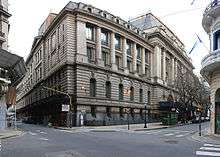

Secondary education in Argentina is called Polimodal ("polymodal", that is, having multiple modes), since it allows the student to choose his/her orientation. Polimodal is usually 3 years of schooling, although some schools have a fourth year. Before entering the first year of polimodal, students choose an orientation, among these five: Humanities and Social Sciences, Economics and Management of Organizations, Art and Design, Health and Sport and Biology and Natural Sciences.
Nevertheless, in Buenos Aires, secondary education consists of 5 years, called from 1st year to 5th year, as opposed to primary education's 1st to 7th grade. Most schools don't require students to choose their orientation, as they study the basic such as maths, biology, art, history and technology, but there are schools that do, whether they are orientated to a certain profession or they have orientations to choose from when they reach a specific year.
Some high schools depend on the University of Buenos Aires, and these require an admission course when students are taking the last year of high school. These high schools are ILSE, CNBA, Escuela Superior de Comercio Carlos Pellegrini and Escuela de Educación Técnica Profesional en Producción Agropecuaria y Agroalimentaria (School of Professional Technique Education in Agricultural and Agri-food Production). The last two do have a specific orientation.
In December 2006 the Chamber of Deputies of the Argentine Congress passed a new National Education Law restoring the old system of primary followed by secondary education, making secondary education obligatory and a right, and increasing the length of compulsory education to 13 years. The government vowed to put the law in effect gradually, starting in 2007.[146]
University education
There are many public universities in Argentina, as well as a number of private universities. The University of Buenos Aires, one of the top learning institutions in South America, has produced five Nobel Prize winners and provides taxpayer-funded education for students from all around the globe.[147][148][149] Buenos Aires is a major center for psychoanalysis, particularly the Lacanian school. Buenos Aires is home to several private universities of different quality, such as: Universidad Argentina de la Empresa, Buenos Aires Institute of Technology, CEMA University, Favaloro University, Pontifical Catholic University of Argentina, University of Belgrano, University of Palermo, University of Salvador, Universidad Abierta Interamericana, Universidad John F. Kennedy, Universidad de Ciencias Empresariales y Sociales, Universidad del Museo Social Argentino, Universidad Austral and Torcuato di Tella University.
Tourism
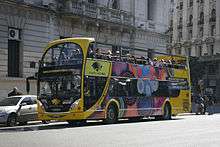
According to the World Travel & Tourism Council,[151] tourism has been growing in the Argentine capital since 2002. In a survey by the travel and tourism publication Travel + Leisure Magazine in 2008, travellers voted Buenos Aires the second most desirable city to visit after Florence, Italy.[152] In 2008, an estimated 2.5 million visitors visited the city.[153]
Visitors have many options such as going to a tango show, an estancia in the Province of Buenos Aires, or enjoying the traditional asado. New tourist circuits have recently evolved, devoted to famous Argentines such as Carlos Gardel, Eva Perón or Jorge Luis Borges. Before 2011, due to the favourable exchange rate, its shopping centres such as Alto Palermo, Paseo Alcorta, Patio Bullrich, Abasto de Buenos Aires and Galerías Pacífico were frequently visited by tourists. The exchange rate today has hampered tourism and shopping in particular. Notable consumer brands such as Tiffany & Co. have abandoned the country due to the exchange rate and import restrictions. The city also plays host to musical festivals, some of the largest of which are Quilmes Rock, Creamfields BA, Ultra Music Festival (Buenos Aires) and the Buenos Aires Jazz Festival.
Buenos Aires has also become "a Latin American gay-tourism."[154] An important factor was Argentina's 2001 financial crisis, with the subsequent favorable exchange rate attracting more foreign tourists.[155] Due to the existence of gay-friendly sites, the civil union law of 2002, by 2003 Buenos Aires was being called "Latin America's gay capital".[155] LGBT tourism remains a sector in the city, and points to its nightlife, cultural and artistic diversity, and Argentina's 2010 legalization of same-sex marriage (the first country in Latin America).[156]
Notable streets

- Alvear Avenue passes through the upscale Recoleta area, and is the address for five-star hotels and embassies, many of them former mansions.
- Caminito colorfully restored by local artist Benito Quinquela Martín
- Corrientes Avenue a principal thoroughfare in Buenos Aires, and intimately tied to the Tango and Porteño culture
- Liberator Avenue connects downtown to upscale areas in the northwest, passing by many of the city's best-known museums, gardens and cultural points of interest
- May Avenue is often compared with those of Madrid, Barcelona and Paris for its sophisticated buildings of Art Nouveau, Neoclassic and eclectic styles
- Florida Street a downtown pedestrian street
- Avenida 9 de Julio the widest avenue in the world; its name honors Argentina's Independence Day.
Neighborhoods
- Belgrano (tipa-lined residential streets, Tudor architecture and numerous museums)
- La Boca (the old port district still maintains its 19th-century ambiance)
- Palermo (a trendy neighborhood filled with restaurants, shops and clubs called boliches)
- Parque Patricios (technology district)
- Puerto Madero (these 1880-era docklands are now the city's newest neighborhood with a modern skyline and upscale restaurants)
- Recoleta (the traditionally upscale district combines Parisian architecture with trendy high rises and a variety of cultural venues)
- Retiro (Art Nouveau cafés and restaurants among Art Deco office architecture)
- San Telmo (one of the oldest neighborhoods of Buenos Aires, this area is characterized by well-preserved 19th-century architecture)
Parks
- Parque Tres de Febrero (this park, one of the city's largest, is home to a rose garden and paddle boat lake)
- Botanical Gardens (among the oldest in Latin America and an easy walk to other Palermo-area sights)
- Buenos Aires Japanese Gardens (the largest of its type in the World, outside Japan)[157]
- Plaza de Mayo (surrounded by national and city government offices, this square has been central to many of Argentina's historical events)
- Plaza San Martín (central to the Retiro area, the leafy park is surrounded by architectural landmarks)
- Recoleta Cemetery (includes graves of many of Argentina's historical figures, including Eva Perón, several presidents and scientists, as well many among Argentina's influential families)
- Buenos Aires Zoo (renowned for its collection and the Hindu Revival elephant house)
Landmarks
.jpg)
- Cabildo (seat of government house during colonial times)
- Caminito (renowned for Benito Quinquela Martín's pastel hues and wall reliefs)
- Casa Rosada (the official seat of the executive branch of the Argentine government)
- Central Post Office (Reopened as the Bicentennial Cultural Center, now Kirchner Cultural Center)
- City Legislature (the monumental neoclassical building also houses two libraries and a museum)
- Kavanagh building (the Art Deco residential building was the first true skyscraper in Buenos Aires)
- Metropolitan Cathedral (mother church of the Archdiocese of Buenos Aires)
- National Congress (Argentine Parliament)
- National Library (the largest library in Argentina and one of the most important in the Americas)
- National Museum of History (original documents, former presidents' belongings and recreated historical rooms)
- The Obelisk (one of the city's iconic landmarks and a venue for various cultural activities and other events)
- Teatro Colón (an internationally renowned opera house opened in 1908)
- The Water Company Palace (perhaps the world's most ornate water pumping station)
Shopping centers
Theatre
- Teatro Colón
- Cervantes Theatre
- Teatro Gran Rex
- Avenida Theatre
- Teatro General San Martín
- Teatro Nacional
- Teatro Opera
- Teatro Coliseo
Coffee shops
Libraries
Transport
Local roads and personal transport
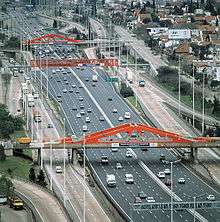
Buenos Aires is based on a square, rectangular grid pattern, save for natural barriers or the relatively rare developments explicitly designed otherwise (notably, the neighbourhood of Parque Chas). The rectangular grid provides for square blocks named manzanas, with a length of roughly 110 metres (361 feet). Pedestrian zones in the city centre, like Florida Street are partially car-free and always bustling, access provided by bus and the Underground (subte) Line C. Buenos Aires, for the most part, is a very walkable city and the majority of residents in Buenos Aires use public transport.
Two diagonal avenues in the city centre alleviate traffic and provide better access to Plaza de Mayo. Most avenues running into and out of the city centre are one-way and feature six or more lanes, with computer-controlled green waves to speed up traffic outside of peak times.
The city's principal avenues include the 140-metre (459 ft)-wide July 9 Avenue, the over-35 km (22 mi)-long Rivadavia Avenue,[158] and Corrientes Avenue, the main thoroughfare of culture and entertainment.
In the 1940s and 1950s the General Paz Avenue beltway that surrounds the city along its border with Buenos Aires Province and freeways leading to the new international airport and to the northern suburbs heralded a new era in Buenos Aires traffic. Encouraged by pro-automaker policies pursued towards the end of the Perón (1955) and Frondizi administrations (1958–62) in particular, auto sales nationally grew from an average of 30,000 during the 1920–57 era to around 250,000 in the 1970s and over 600,000 in 2008.[159] Today, over 1.8 million vehicles (nearly one-fifth of Argentina's total) are registered in Buenos Aires.[160]
Toll motorways opened in the late 1970s by then-mayor Osvaldo Cacciatore provided fast access to the city centre and are today used by over a million vehicles daily.[161] Cacciatore likewise had financial district streets (roughly one square km in area) closed to private cars during daytime. Most major avenues are, however, gridlocked at peak hours. Following the economic mini-boom of the 1990s, record numbers started commuting by car and congestion increased, as did the time-honored Argentine custom of taking weekends off in the countryside.
Cycling
In December 2010, the city government launched a bicycle sharing program with bicycles free for hire upon registration. Located in mostly central areas, there are 31 rental stations throughout the city providing over 850 bicycles to be picked up and dropped off at any station within an hour.[162] As of 2013, the city has constructed 110 km (68.35 mi) of protected bicycle lanes and has plans to construct another 100 km (62.14 mi).[163] In 2015, the stations were automated and the service became 24 hours through use of a smart card or mobile phone application.
Local public transport
Commuter rail
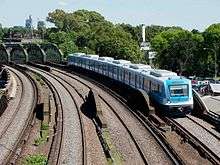

The Buenos Aires commuter rail system has seven lines:
The Buenos Aires commuter network system is very extensive: every day more than 1.3 million people commute to the Argentine capital. These suburban trains operate between 4 am and 1 am. The Buenos Aires commuter rail network also connects the city with long-distance rail services to Rosario and Córdoba, among other metropolitan areas. There are four principal terminals for both long-distance and local passenger services in the city centre: Constitucion, Retiro, Federico Lacroze and Once, while Buenos Aires station is a minor terminus.
Commuter rail in the city is mostly operated by the state-owned Trenes Argentinos, though the Urquiza Line and Belgrano Norte Line are operated by private companies Metrovías and Ferrovías respectively.[164][165][166] All services had been operated by Ferrocarriles Argentinos until the company's privatisation in 1993, and were then operated by a series of private companies until the lines were put back under state control following a series of high-profile accidents.[167][168]
Since 2013, there has been a series of large investments on the network, with all lines (with the exception of the Urquiza Line) receiving new rolling stock, along with widespread infrastructure improvements, track replacement, electrification work, refurbishments of stations and building entirely new stations.[169][170][171] Similarly, almost all level crossings have been replaced by underpasses and overpasses in the city, with plans to replace all of them in the near future.[172] One of the most major projects under way is the electrification of the remaining segments of the Roca Line – the most widely used in the network – and also moving the entire section of the Sarmiento Line which runs through the centre of the city underground to allow for better frequencies on the line and reduce congestion above ground.[173][174]
There are also three other major projects on the table. The first would elevate a large segment of the San Martín Line which runs through the centre of the city and electrify the line, while the second would see the electrification and extension of the Belgrano Sur Line to Constitucion station in the centre of the city.[175][176] If these two projects are completed, then the Belgrano Norte Line would be the only diesel line to run through the city. The third and most ambitious is to build a series of underground tunnels between three of the city's railway terminals with a large underground central station underneath the Obelisk, connecting all the commuter railway lines in a network dubbed the Red de Expresos Regionales.[177]
Underground
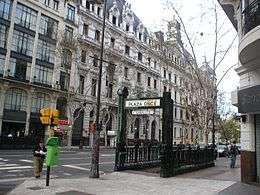

The Buenos Aires Underground (locally known as subte, from "subterráneo" meaning underground or subway), is a high-yield system providing access to various parts of the city. Opened in 1913, it is the oldest underground system in the Southern Hemisphere and oldest in the Spanish-speaking world. The system has six underground lines and one overground line, named by letters (A to E, and H) and there are 100 stations, and 58.8 km (37 mi) of route, including the Premetro line.[178] An expansion program is underway to extend existing lines into the outer neighborhoods and add a new north-south line. Route length is expected to reach 89 km (55 mi) by 2011.
Line A is the oldest one (service opened to public in 1913) and stations kept the "belle-époque" decoration, while the original rolling stock from 1913, affectionately known as Las Brujas were retired from the line in 2013. Daily ridership on weekdays is 1.7 million and on the increase.[179][180] Fares remain relatively cheap, although the city government raised fares by over 125% in January 2012. A single journey, with unlimited interchanges between lines, now costs AR$3.50, which is roughly USD$0.60.[181]
The most recent expansions to the network were the addition of numerous stations to the network in 2013: San José de Flores and San Pedrito to Line A, Echeverría and Juan Manuel de Rosas to Line B and Hospitales to Line H. Current works include the completion of Line H northwards and addition of three new stations to Line E in the centre of the city.[182][183] The construction of Line F is due to commence in 2015,[184] while two other lines are planned for construction in the future.
Tramways
Buenos Aires had an extensive street railway (tram) system with over 857 km (533 mi) of track, which was dismantled during the 1960s in favour of bus transportation, but surface rail transport has made a small comeback in some parts of the city. The PreMetro or Line E2 is a 7.4 km (4.6 mi) light rail line that connects with Underground Line E at Plaza de los Virreyes station and runs to General Savio and Centro Cívico. It is operated by Metrovías. The official inauguration took place on 27 August 1987.
A 2 km (1.2 mi) modern tramway, the Tranvía del Este, opened in 2007 in the Puerto Madero district, using two tramcars on temporary loan. However, plans to extend the line and acquire a fleet of trams did not come to fruition, and declining patronage led to the line's closure in October 2012.[185] A heritage streetcar maintained by tram fans operates on weekends, near the Primera Junta line A Underground station in the Caballito neighbourhood.
Buses
There are over 150 city bus lines called Colectivos, each one managed by an individual company. These compete with each other, and attract exceptionally high use with virtually no public financial support.[186] Their frequency makes them equal to the underground systems of other cities, but buses cover a far wider area than the underground system. Colectivos in Buenos Aires do not have a fixed timetable, but run from four to several per hour, depending on the bus line and time of the day. With inexpensive tickets and extensive routes, usually no further than four blocks from commuters' residences, the colectivo is the most popular mode of transport around the city.[186]
Buenos Aires has recently opened a bus rapid transit system, the Metrobus. The system uses modular median stations that serve both directions of travel, which enable pre-paid, multiple-door, level boarding. The first line, opened on 31 May 2011, runs across the Juan B. Justo Ave has 21 stations.[187] The system now has 4 lines with 113 stations on its 43.5 km (27.0 mi) network, while numerous other lines are under construction and planned.[188]
Taxis
A fleet of 40,000 black-and-yellow taxis ply the streets at all hours. License controls are not enforced rigorously. There have been reports of organized crime controlling the access of taxis to the city airports and other major destinations. Taxi drivers are known for trying to take advantage of tourists.[189] Radio-link companies provide reliable and safe service; many such companies provide incentives for frequent users. Low-fare limo services, known as remises, have become popular in recent years.[190][191]
Intercity transport

Ferries
Buenos Aires is also served by a ferry system operated by the company Buquebus that connects the port of Buenos Aires with the main cities of Uruguay, (Colonia del Sacramento, Montevideo and Punta del Este). More than 2.2 million people per year travel between Argentina and Uruguay with Buquebus. One of these ships is a catamaran, which can reach a top speed of about 80 km/h (50 mph).[192]
Airports
The Buenos Aires international airport, which goes by the official name of Ministro Pistarini International Airport, is located in the suburb of Ezeiza and is often called the "Ezeiza International Airport". The Aeroparque Jorge Newbery airport, located in the Palermo district next to the riverbank, serves only domestic traffic and flights to Brazil, Chile, Paraguay and Uruguay. A smaller San Fernando Airport serves only general aviation.
Security
The Guardia Urbana de Buenos Aires (Buenos Aires Urban Guard) was a specialized civilian force of the city of Buenos Aires, Argentina, that used to deal with different urban conflicts with the objective of develop actions of prevention, dissuasion and mediation, promoting effective behaviors that guarantee the security and the integrity of public order and social coexistence. The unit continuously assisted the personnel of the Argentine Federal Police, especially in emergency situations, events of massive concurrence, and protection of tourist establishments.
The group permanently did controls of seat belt use, blood alcohol content tests, and traffic order; also its agents are enabled to offer quick and objective information to tourists and foreign people. Other functions include take part when a public case of intentional damage or negligence happen; anyway, its personnel always must act in a preventive, educative, dissuasive and coordinated form.
The Urban Guard officials did not carry any weapon in the performing of their duties. Their basic tools are an HT radio transmissor and a whistle.
As of March 2008, the Guardia Urbana was removed. Its people were "recycled" into a new law enforcement organization, about traffic order called the Seguridad Vial.
The Buenos Aires Metropolitan Police is the police force under the authority of the Autonomous City (or Federal District) of Buenos Aires. The force was created in 2010 and is composed of 1,850 officers, and is planned to expand to 16,000. Security in the city is concurrently the responsibility of the Metropolitan Police and the Argentine Federal Police.
The city government claims the new force is based on the model of the British London Metropolitan Police and the New York Police Department. The force was intended to use high technology support and adopt a policy of zero tolerance.
The police are headed by a Chief and a Deputy Chief. Both are appointed by the head of the executive branch of the City.
There are four major departments, each headed by a Director General:
- Public Security
- Investigations and Research
- Scientific and Technical
- Administration
Geographically, the force is divided into 15 precincts.
Of the 1,850 officers, 900 are used for patrolling the streets.
Sports
Football is a passion for Argentines. Buenos Aires has the highest concentration of football teams of any city in the world (featuring no fewer than 24 professional football teams),[193] with many of its teams playing in the major league. The best-known rivalry is the one between Boca Juniors and River Plate, the match is better known as Superclásico. Watching a match between these two teams was deemed one of the "50 sporting things you must do before you die" by The Observer.[193] Other major clubs include San Lorenzo de Almagro, Club Atlético Huracán, Vélez Sársfield, Asociación Atlética Argentinos Juniors and Club Ferro Carril Oeste.
Diego Maradona, born in Lanús Partido (county) south of Buenos Aires, is widely hailed as one of the greatest football players of all time. Maradona started his career with Argentinos Juniors, later playing for Boca Juniors, the Argentina national football team and others (most notably FC Barcelona in Spain and SSC Napoli in Italy).[194]
Argentina has been the home of world champions in professional boxing. Carlos Monzon was a hall of fame World Middleweight champion, and the current undisputed linear Middleweight champion Sergio Martinez hails from Argentina. Omar Narvaez, Lucas Matthysse, Carolina Duer, and Marcos Maidana are five modern-day world champions as well.

Buenos Aires has been a candidate city for the Summer Olympic Games on three occasions: for the 1956 Games, which were lost by a single vote to Melbourne; for the 1968 Summer Olympics, held in Mexico City; and in 2004, when the games were awarded to Athens. However, Buenos Aires hosted the first Pan American Games (1951)[92] and was also host city to several World Championship events: the 1950 and 1990 Basketball World Championships, the 1982 and 2002 Men's Volleyball World Championships and, most remembered, the 1978 FIFA World Cup, won by Argentina on 25 June 1978, when it defeated the Netherlands at the Estadio Monumental 3–1. In September 2013, the city hosted the 125th IOC Session, Tokyo was elected the host city of the 2020 Summer Olympics and Thomas Bach was new IOC President. Buenos Aires bid to host the 2018 Summer Youth Olympics.[195] On 4 July 2013, the IOC elected Buenos Aires as the host city.[13] Buenos Aires hosted the 2006 South American Games too.
Juan Manuel Fangio won five Formula One World Driver's Championships, and was only outstripped by Michael Schumacher, with seven Championships. The Buenos Aires Oscar Gálvez car-racing track hosted 20 Formula One events as the Argentine Grand Prix, between 1953 and 1998; it was discontinued on financial grounds. The track features various local categories on most weekends.
The 2009, 2010, 2011, 2015 Dakar Rally started and ended in the city.
The first rugby union match in Argentina was played in 1873 in the Buenos Aires Cricket Club Ground, located in Palermo neighbourhood, where the Galileo Galilei planetarium is located today. Rugby enjoys widespread popularity in Buenos Aires, most especially in the north of the city, which boasts more than eighty rugby clubs. The city is home to the Argentine Super Rugby franchise, the Jaguares. The Argentina national rugby union team competes in Buenos Aires in international matches such as the Rugby Championship.
Argentines' love for horses can be experienced in several ways: horse racing at the Hipódromo Argentino de Palermo racetrack, polo in the Campo Argentino de Polo (located just across Libertador Avenue from the Hipódromo), and pato, a kind of basketball played on horseback that was declared the national game in 1953.
Buenos Aires native Guillermo Vilas (who was raised in Mar del Plata) and Gabriela Sabatini were great tennis players of the 1970s and 1980s [92] and popularized tennis Nationwide in Argentina. Vilas won the ATP Buenos Aires numerous times in the 1970s. Other popular sports in Buenos Aires are golf, basketball, rugby and field hockey.

Notable people
Notable people originally from Buenos Aires:
-
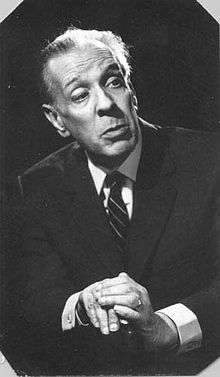
Writer, Jorge Luis Borges
-
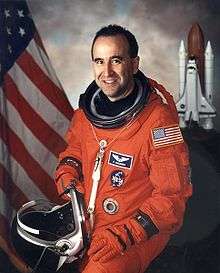
Argentine NASA astronaut, Fernando Caldeiro
-

Gustavo Cerati, singer-songwriter, composer and producer
International relations
World rankings
Buenos Aires is classified as an Alpha World City, according to the Loughborough University group's (GaWC) 2008 inventory.[196] It is ranked 22nd in the 2010 ranking of global cities by the American journal Foreign Policy, in conjunction with consulting firm A.T. Kearney and the Chicago Council on Global Affairs. (See "Global city" for the top 30 in the list).
Twin towns and sister cities
Buenos Aires is twinned with the following cities:[197]
 Beijing, China (since 1993)[198]
Beijing, China (since 1993)[198] Berlin, Germany (since 19 May 1994)[199][200]
Berlin, Germany (since 19 May 1994)[199][200] Bilbao, Spain
Bilbao, Spain Brasília, Brazil[201]
Brasília, Brazil[201] Cairo, Egypt[202]
Cairo, Egypt[202] Cádiz, Spain
Cádiz, Spain Calabria, Italy (region)
Calabria, Italy (region) Guadix, Spain[202]
Guadix, Spain[202] Miami, Florida, United States
Miami, Florida, United States Moscow, Russia[202]
Moscow, Russia[202] Naples, Italy
Naples, Italy Osaka, Japan
Osaka, Japan Oviedo, Spain (since 1983)
Oviedo, Spain (since 1983) Prague, Czech Republic
Prague, Czech Republic Salamanca, Spain
Salamanca, Spain Santiago de Compostela, Spain
Santiago de Compostela, Spain São Paulo, Brazil[203][204]
São Paulo, Brazil[203][204] Seville, Spain[205]
Seville, Spain[205] Tel Aviv, Israel (since 1976)
Tel Aviv, Israel (since 1976) Vigo, Spain
Vigo, Spain Warsaw, Poland[202]
Warsaw, Poland[202] Yerevan, Armenia (since 2000)[206]
Yerevan, Armenia (since 2000)[206] Zagreb, Croatia (since 1998)[207]
Zagreb, Croatia (since 1998)[207]
Union of Ibero-American Capital Cities
Buenos Aires is part of the Union of Ibero-American Capital Cities[208] from 12 October 1982 establishing brotherly relations with the following cities:
 Andorra la Vella, Andorra
Andorra la Vella, Andorra Asunción, Paraguay
Asunción, Paraguay Bogotá, Colombia
Bogotá, Colombia Buenos Aires, Argentina
Buenos Aires, Argentina Caracas, Venezuela
Caracas, Venezuela Guatemala City, Guatemala
Guatemala City, Guatemala Havana, Cuba
Havana, Cuba Quito, Ecuador
Quito, Ecuador La Paz, Bolivia
La Paz, Bolivia Lima, Peru
Lima, Peru Lisbon, Portugal
Lisbon, Portugal Madrid, Spain
Madrid, Spain Managua, Nicaragua
Managua, Nicaragua Mexico City, Mexico
Mexico City, Mexico Montevideo, Uruguay
Montevideo, Uruguay Panama City, Panama
Panama City, Panama Rio de Janeiro, Brazil
Rio de Janeiro, Brazil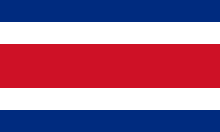 San Jose, Costa Rica
San Jose, Costa Rica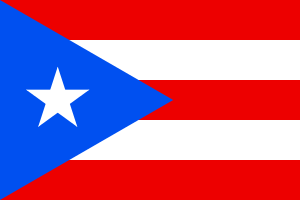 San Juan, Puerto Rico
San Juan, Puerto Rico San Salvador, El Salvador
San Salvador, El Salvador Santiago, Chile
Santiago, Chile Santo Domingo, Dominican Republic
Santo Domingo, Dominican Republic Tegucigalpa, Honduras
Tegucigalpa, Honduras
Partner city
See also
- C40 Cities Climate Leadership Group
- Largest cities in the Americas
- List of mayors and chiefs of government of Buenos Aires
- List of twin towns and sister cities of Buenos Aires
- OPENCities
- Outline of Argentina
References
Sources
- Encyclopædia Britannica
- Microsoft Encarta (Archived 2009-10-31)
- General Information
- (Spanish) Patricia Moglia, Fabián Sislián and Mónica Alabart, Pensar la historia Argentina desde una historia de América Latina, Buenos Aires:Plus Ultra
Notes
- 1 2 3 "Censo 2010. Resultados provisionales: cuadros y grá" (in Spanish). Archived from the original on 20 December 2010. Retrieved 25 February 2011.
- ↑ "Informe Nacional sobre Desarrollo Human 2013 Argentina en un mundo incierto: Asegurar el desarrollo humano en el siglo XXI" (PDF) (in Spanish). United Nations Development Programme. p. 143. Archived from the original (PDF) on 25 March 2014. Retrieved 25 March 2014.
- ↑ "Buenos Aires City". The American Heritage Dictionary of the English Language. Boston: Houghton Mifflin Harcourt. 2001. Archived from the original on 18 July 2011.
- ↑ "Buenos Aires Stay Apartments". Retrieved 25 May 2013.
- ↑ Ruiz Moreno, Isidro (1986). La federalización de Buenos Aires: debates y documentos. Buenos Aires: Buenos Aires: Hyspamerica. ISBN 950-614-467-2.
- ↑ "The World According to GaWC 2010". Globalization and World Cities Research Network. Archived from the original on 10 October 2013. Retrieved 15 April 2012.
- ↑ "2012 Quality Of Living Worldwide City Rankings Survey" (PDF). Mercer. Retrieved 27 June 2015.
- ↑ Cox, Wendell. "The Two Worlds of Buenos Aires". newgeography.com. Retrieved 18 January 2015.
- ↑ "México DF, Buenos Aires y San Pablo, los destinos turísticos favoritos". Infobae (in Spanish). Retrieved 18 January 2015.
- ↑ "Buenos Aires Travel Guide". Travel + Leisure. Retrieved 2 May 2012.
- ↑ "Introduction to architecture in Buenos Aires". Lonely Planet. 14 June 2011. Retrieved 18 January 2015.
- ↑ "Buenos Aires History and Culture". Adventure Life. Retrieved 28 May 2012.
- 1 2 "Buenos Aires elected as Host City for 2018 Youth Olympic Games". International Olympic Committee. 4 July 2013. Retrieved 13 September 2013.
- ↑ Niebieskikwiat, Natasha. "Argentina fue elegida sede del G-20 para 2018". clarin.com.
- ↑ Buenos Aires Ciudad. "Turismo Religioso" (in Spanish). Retrieved 25 November 2015.
- 1 2 "Origin of the name Buenos Aires". Todo Buenos Aires. Retrieved 18 January 2015.
- 1 2 "Nuestro Banderín" (in Spanish). Buenos Aires Rotary Club. Retrieved 18 January 2015.
- ↑ "Massimo Pittau – La Madonna di Bonaria di Cagliari e Buenos Aires". pittau.it.
- ↑ "Quel legame mariano tra Bonaria e Buenos Aires". avvenire.it.
- ↑ B. Martinez, Alberto (1889). Estudio topográfico é historia demografica de la ciudad de Buenos Aires. Buenos Aires: Compañía Sud-Americana de Billetes de Banco. p. 14.
- 1 2 3 "Calendario Histórico – Segunda fundación de Buenos Aires" (in Spanish). Government of the Autonomous City of Buenos Aires. Archived from the original on 24 October 2012. Retrieved 9 February 2012.
- ↑ "Spanish Abbreviations". About.com. Retrieved 18 January 2015.
- ↑ "BA Abbreviation". allacronyms.com. Retrieved 18 January 2015.
- 1 2 3 Argentina: A Short History by Colin M. Lewis, Oneworld Publications, Oxford, 2002. ISBN 1-85168-300-3
- ↑ Aborígenes de la Argentina. (Spanish) John D. Torres Barreto. Retrieved 9 February 2012. Archived 5 June 2014 at the Wayback Machine.
- ↑ Pedro de Mendoza. (Spanish) Retrieved 8 February 2012. Archived 11 July 2014 at the Wayback Machine.
- ↑ Diego Armus, The Ailing City: Health, Tuberculosis, and Culture in Buenos Aires, 1870–1950 (2011)
- ↑ Guía visual de Buenos Aires centro histórico, Clarín Viajes, 2001.
- ↑ We are Millions: Neo-liberalism and new forms of political action in Argentina, Marcela Lópéz Levy, Latin America Bureau, London, 2004. ISBN 978-1899365630
- ↑ "Declaró el maquinista y fue excarcelado: "Intenté frenar dos veces, pero el mecanismo falló"". Clarín (in Spanish). 24 February 2012. Retrieved 13 September 2012.
- ↑ Rozenwasser, Einat (25 February 2012). "Un operativo que resultó eficaz pero que ahora revela fallas". Clarín (in Spanish). Retrieved 25 February 2012.
- ↑ Ciudad Autónoma de Buenos Aires (1 October 1996). "Constitución de la Ciudad Autónoma de Buenos Aires" (in Spanish). Archived from the original on 22 January 2008. Retrieved 13 December 2007.
- ↑ "''Infobae'': Qué dice la Ley Cafiero" (in Spanish). Infobae.com. 30 January 2011. Retrieved 2 May 2012.
- ↑ ": Policía Metropolitana :". Metropolitana.gob.ar. Archived from the original on 3 September 2011. Retrieved 15 September 2011.
- ↑ Elecciones 2011 – Perfil
- ↑ Más de 300 mil porteños probaron ayer el voto electrónico – InformateSalta, 27 April 2015
- ↑ Elecciones porteñas 2015: amplio triunfo de Horacio Rodríguez Larreta, pero habrá ballottage con Martín Lousteau – La Nacion, 5 July 2015
- ↑ Mapa de resultados ballottage – La Nacion, 19 July 2015.
- ↑ Senate of the Nation. Retrieved 18 March 2016.
- ↑ Ann Breen and Dick Rigby, The New Waterfront: A Worldwide Urban Success Story – McGraw-Hill Professional
- 1 2 "Censo 2010". Retrieved 20 October 2015.
- ↑ "Censo 2010 Argentina". www.censo2010.indec.gov.ar. Retrieved 20 October 2015.
- ↑ "Indec:Instituto Nacional De Estadistica Y Censos De La Republica Argentina". Indec.mecon.ar?censo2001s2_2. Retrieved 1 June 2011.
- 1 2 "2001 Census". Retrieved 9 August 2009.
- ↑ "Buenos Aires Statistical Monthly, June 2008". Buenosaires.gov.ar. Archived from the original on 19 September 2009. Retrieved 9 August 2009.
- ↑ "Four million live in poverty in metropolitan Buenos Aires". En.mercopress.com. Retrieved 9 August 2009.
- ↑ Government of Buenos Aires. Retrieved 7 August 2006.
- ↑ 'Buenos Aires con quince comunas' by Pedro Lipcovich, Página/12, 2 September 2005
- ↑ Enrique Oteiza y Susana Novick sostienen que "la Argentina desde el siglo XIX, al igual que Australia, Canadá o Estados Unidos, se convierte en un país de inmigración, entendiendo por esto una sociedad que ha sido conformada por un fenómeno inmigratorio masivo, a partir de una población local muy pequeña." (Oteiza, Enrique; Novick, Susana. Inmigración y derechos humanos. Política y discursos en el tramo final del menemismo. in línea]. Buenos Aires: Instituto de Investigaciones Gino Germani, Facultad de Ciencias Sociales, Universidad de Buenos Aires, 2000 (IIGG Documentos de Trabajo, N° 14): http://www.iigg.fsoc.uba.ar/docs/dt/dt14.pdf); Ribeiro, Darcy. Las Américas y la Civilización (1985). Buenos Aires:EUDEBA, pp. 449 ss.; José Luis Romero (Romero, José Luis. "Indicación sobre la situación de las masas en Argentina (1951)", in La experiencia argentina y otros ensayos, Buenos Aires: Universidad de Belgrano, 1980, p. 64)
- ↑ "Buenos Aires Introduction". Geographia.com. Retrieved 9 August 2009.
- ↑ Solberg, Carl (May 1969). "Immigration and Urban Social Problems in Argentina and Chile, 1890–1914". The Hispanic American Historical Review. Duke University Press. 49 (2): 215–232. doi:10.2307/2510818. JSTOR 2510818.
- ↑ "European Emigration to Argentina". Casahistoria.net. 17 July 2009. Retrieved 9 August 2009.
- ↑ Weiner, Rebecca. "The Virtual Jewish History Tour – Argentina". Retrieved 9 January 2008.
- 1 2 3 "Colectividad China y Taiwanesa" (in Spanish). Government of the City of Buenos Aires. Retrieved 2 April 2015.
- ↑ Rodiño, Silvia (6 March 2006). "El secreto de los negocios chinos" (in Spanish). Clarín. Clarín Group. Retrieved 2 April 2015.
- ↑ "Colectividad Japonesa" (in Spanish). Government of the City of Buenos Aires. Retrieved 2 April 2015.
- ↑ "Colectividad Coreana" (in Spanish). Government of the City of Buenos Aires. Retrieved 2 April 2015.
- 1 2 3 4 "Censo Nacional de Población, Hogares y Viviendas 2010: Pueblos Originarios: Región Metropolitana: Serie D No 6" (PDF) (in Spanish). INDEC. Retrieved 5 December 2015.
- ↑ "Cuadro P42-P. Ciudad Autónoma de Buenos Aires. Población afrodescendiente en viviendas particulares por sexo, según grupo de edad. Año 2010" (PDF) (in Spanish). INDEC. Retrieved 5 December 2015.
- 1 2 (Spanish) Los ateos siguen en alza y ya son la segunda ‘religión’ – Diario Perfil – Domingo 14 de diciembre de 2008
- ↑ "Presentación de PowerPoint" (PDF). Retrieved 9 August 2009.
- ↑ "Largest Mosque in Latin America Opens". Beliefnet. Retrieved 12 February 2016.
- ↑ sustainablecitiesnetwork (13 July 2011). "How much green space does your city have?". wordpress.com.
- ↑ http://www.defensoria.org.ar/publicaciones/pdf/justa13A.pdf
- ↑ "Cuenca del Plata". Borello.com.ar. Archived from the original on 26 July 2013. Retrieved 13 September 2013.
- ↑ "Geografia de Argentina". Argentinaxplora.com. Retrieved 13 September 2013.
- ↑ "Sitio oficial de turismo de la Ciudad de Buenos Aires | LA CIUDAD DE TODOS LOS ARGENTINOS" (in Spanish). Bue.gov.ar. Archived from the original on 21 February 2009. Retrieved 13 September 2013.
- ↑ Peel, M. C.; Finlayson B. L.; McMahon, T. A. (2007). "Updated world map of the Köppen−Geiger climate classification" (PDF). Hydrol. Earth Syst. Sci. 11: 1633–1644. doi:10.5194/hess-11-1633-2007. ISSN 1027-5606.
- ↑ "Monthly Information of the city of Buenos Aires, January in the city of Buenos Aires" (in Spanish). Servicio Meteorológico Nacional (Argentine National Meteorological Service). Retrieved 23 January 2008.
- ↑ "Atlas Ambiental de Buenos Aires". AABA (in Spanish). 19 April 2010. Retrieved 19 April 2010.
- ↑ "Monthly Information of the city of Buenos Aires, July in the city of Buenos Aires" (in Spanish). Servicio Meteorológico Nacional (Argentine National Meteorological Service). Retrieved 23 January 2008.
- ↑ "Buenos Aires sees rare snowfall". BBC News. 10 July 2007. Retrieved 24 January 2008.
- ↑ "Buenos Aires gets first snow since 1918". USA Today. 9 July 2007. Retrieved 24 January 2008.
- 1 2 "Climate Statistics for Buenos Aires 1981–1990" (in Spanish). Servicio Meteorológico Nacional. Retrieved 9 August 2009.
- ↑
- "Temperatura maxima media" (in Spanish). Departamento de Ciencias de la Atmósfera y los Océanos, University of Buenos Aires. Retrieved 16 March 2015.
- "Temperatura Media" (in Spanish). Departamento de Ciencias de la Atmósfera y los Océanos, University of Buenos Aires. Retrieved 16 March 2015.
- "Temperatura Mínima Media" (in Spanish). Departamento de Ciencias de la Atmósfera y los Océanos, University of Buenos Aires. Retrieved 16 March 2015.
- "Precipitación media mensual" (in Spanish). Departamento de Ciencias de la Atmósfera y los Océanos, University of Buenos Aires. Retrieved 16 March 2015.
- "Días con precipitación" (in Spanish). Departamento de Ciencias de la Atmósfera y los Océanos, University of Buenos Aires. Retrieved 16 March 2015.
- "Heliofanía (hs. del sol directo)" (in Spanish). Departamento de Ciencias de la Atmósfera y los Océanos, University of Buenos Aires. Retrieved 16 March 2015.
- ↑ "Economía" (PDF) (in Spanish). Archived from the original (PDF) on 25 March 2009. Retrieved 22 January 2010.
- ↑ "Distribution of Gross Value Added by jurisdiction and economic activity" (in Spanish). Producto Bruto Geografico. Archived from the original on 13 March 2008. Retrieved 22 January 2010.
- ↑ "City Mayors reviews the richest cities in the world in 2005". Citymayors.com. 11 March 2007. Retrieved 5 May 2009.
- ↑ "'Informe Argentino Sobre Desarrollo Humano'". Web.archive.org. 9 October 2007. Archived from the original on 9 October 2007. Retrieved 9 August 2009.
- ↑ "Puerto Buenos Aires: Estadísticas" (PDF). Archived from the original (PDF) on 6 July 2011.
- ↑ "Dock Sud". World Port Source. Retrieved 2 May 2012.
- ↑ McDonnell, Patrick J. (19 July 2008). "Argentina ends grain tax hike". Los Angeles Times. Archived from the original on 3 August 2008. Retrieved 19 July 2008.
- 1 2 3 "City of Buenos Aires Statistical Annual (2008)". Buenosaires.gov.ar. Archived from the original on 19 September 2009. Retrieved 9 August 2009.
- ↑ "abril 2008 para pdf.indd" (PDF). Archived from the original (PDF) on 24 October 2012. Retrieved 9 August 2009.
- ↑ "Presupuesto 2011" (PDF). Retrieved 25 February 2011.
- ↑ "Cristina inaugura el Centro Cultural Néstor Kirchner", Perfil, 21 May 2015
- ↑ "Las impactantes fotos del Centro Cultural Néstor Kirchner", Ambito Financiero, 20 May 2015
- ↑ "La obra faraónica del legado cultural K", Los Andes, 31 May 2015
- ↑ 'Paris of the South' by Kenneth Bagnell, Canoe travel, 7 March 2005.
- ↑ Entertainment boom hits Buenos Aires by Charles Newbery, Variety.com. Posted: Sat., 25 June 2011, 4:00 am PT
- ↑ La Nacion, 2014.
- 1 2 3 4 Time Out Guide: Buenos Aires, Cathy Runciman & Leticia Saharrea (eds), Penguin Books, London, 2001. ISBN 0-14-029398-1
- ↑ "El Filete Porteño es Patrimonio Cultural Inmaterial de la Humanidad". Government of the City of Buenos Aires. December 2, 2015. Retrieved December 18, 2015.
- 1 2 3 Bredow, Susan (20 June 2015). "Best Art in Buenos Aires". Herald Sun. The Herald and Weekly Times. Retrieved 3 February 2016.
- ↑ Bernhardson, Wayne (14 October 2008). Moon Buenos Aires. Avalon Travel. p. 136. ISBN 978-1566919913.
- ↑ Chesterton, Matt (August 2014). "Best Art in Buenos Airespast". Travel + Leisure. Time Inc. Retrieved 3 February 2016.
- ↑ "Museos de la ciudad" (in Spanish). Government of the City of Buenos Aires. Retrieved 3 February 2016.
- ↑ "La Noche de los Museos" (in Spanish). Government of the City of Buenos Aires. Retrieved 3 February 2016.
- ↑ "Free Things to Do in Buenos Aires". National Geographic. Retrieved 3 February 2016.
- ↑ Battistozzi, Ana María (August 2005). "La ciudad: arte y utopías" (in Spanish). Centro Virtual de Arte Argentino. Retrieved November 18, 2016.
- ↑ Babino, Malena (September 2007). "El grupo de París" (in Spanish). Centro Virtual de Arte Argentino. Retrieved November 18, 2016.
- ↑ Battiti, Florencia; Mezza, Cintia (August 2006). "La Boca Artists". Centro Virtual de Arte Argentino. Retrieved November 18, 2016.
- 1 2 3 Calatrava, Almudena (5 June 2013). "Argentina Welcomes Street Art, Buenos Aires Is Canvass For International Artists, Muralists". The Huffington Post. TheHuffingtonPost.com, Inc. Retrieved 3 February 2016.
- 1 2 McFarlane, Nyree (28 April 2015). "The street art of Buenos Aires". stuff.co.nz. Retrieved 3 February 2016.
- ↑ Gorski, Alana (24 January 2016). "El arte callejero se expande por la Ciudad de Buenos Aires". Infobae. Retrieved 3 February 2016.
- ↑ "El street art de Buenos Aires seduce al mundo". Clarín. Clarín Group. 21 June 2013. Retrieved 3 February 2016.
- ↑ Komi Kallinikos, Christina (2003). "La ciudad literaria, portador material e inmaterial de memoria". Revista del Centro de Letras Hispanoamericanas (in Spanish). Vol. 12 no. 15. Mar del Plata, Argentina: National University of Mar del Plata. Retrieved 5 February 2016.
- 1 2 3 4 Goñi, Uki (20 June 2015). "A novel oasis: why Argentina is the bookshop capital of the world". The Guardian. Guardian News and Media Limited. Retrieved 2 February 2016.
- ↑ "Top shelves". The Guardian. Guardian News and Media Limited. 11 January 2008. Retrieved 3 February 2016.
- ↑ "Buenos Aires Book Fair". Fundación El Libro. Retrieved 3 February 2016.
- ↑ "Napolitanos y porteños, unidos por el acento". Lanacion.com.ar. Retrieved 13 September 2013.
- ↑ A sense of where you were
- 1 2 3 4 5 6 The Harvard Dictionary of Music. Belknap Press. 28 November 2003. pp. 53–54. ISBN 978-0674011632.
- 1 2 "Tanguerías, milongas y clases de tango" (in Spanish). Government of the City of Buenos Aires. Retrieved 8 February 2016.
- ↑ "Compositores" (in Spanish). Government of the City of Buenos Aires. Archived from the original on 14 February 2016. Retrieved 8 February 2016.
- ↑ "Tango on UNESCO world heritage list". Huffington Post. 30 September 2009. Retrieved 1 June 2011.
- 1 2 Almendra (1992). Almendra (Media notes). CD Liner notes by Rafael Abud. RCA Records.
- ↑ Kleiman, Claudio (10 August 2002). "El grupo que en los '60 inventó el rock en castellano". Página/12 (in Spanish). Retrieved 30 January 2016.
- 1 2 Velázquez Delgado, Jorge (15 July 2011). Imaginarios utópicos en la cultura: De las utopías renacentistas a las posindustriales (in Spanish). Kazak Ediciones. p. 31.
- 1 2 Torrón, Andrés (7 February 2016). "Todo sigue teniendo música". El Observador (in Spanish). El Observador. Retrieved 6 February 2016.
- 1 2 Riera, Daniel (1 July 2001). "El ritmo de la villa". Rolling Stone Argentina (in Spanish). La Nación. Retrieved 24 February 2016.
- ↑ Martyniuk, Claudio (26 February 2012). "La cumbia villera es una gran ventana para ver cómo se procesa la desigualdad". Clarín (in Spanish). Clarín Group. Retrieved 24 February 2016.
- ↑ de los Reyes, Ignacio (6 January 2016). "Cumbia cheta: el ritmo tropical que ahora baila la clase alta en Argentina" (in Spanish). BBC Mundo. BBC World Service. Retrieved 24 February 2016.
- 1 2 Sendrós, Paraná. "Historia del Cine Argentino (1896–1945)" (in Spanish). El Sur del Sur. Retrieved 29 February 2016.
- 1 2 3 4 5 "Cultura: Cine" (in Spanish). Presidency of the Argentine Nation. Retrieved 29 February 2016.
- ↑ Sendrós, Paraná. "El Cine Argentino (1945–1995)" (in Spanish). El Sur del Sur. Retrieved 29 February 2016.
- ↑ "Museo del Cine: Historia" (in Spanish). Government of the City of Buenos Aires. Retrieved 29 February 2016.
- ↑ "Un festival en constante crecimiento" (in Spanish). Government of the City of Buenos Aires. Retrieved 29 February 2016.
- ↑ Espsäter, María M. (8 August 2014). Uruguay Focus: Includes Montevideo, Punta del Este, Colonia del Sacramento. Footprint Travel Guides. p. 92. ISBN 978-1909268722.
- ↑ Davies, Catherine; Owen, Hilary; Brewster, Claire (3 January 2007). South American Independence: Gender, Politics, Text. Oxford University Press. p. 266. ISBN 978-1846316845.
- ↑ Greenberg, Arnold; Tristan, Linda (1999). Buenos Aires and the Best of Argentina Alive!. Hunter Publishing. p. 1992. ISBN 1556508816.
- ↑ "BAFWeek cumple 10 años". Vos.lavoz.com.ar. Retrieved 2 May 2012.
- ↑ Roberts, Mhairi (6 July 2011). "Top 5 Argentine Fashion Designers". The Argentina Independent. Retrieved 1 September 2016.
- ↑ New York Regains Fashion Capital Crown from Milan Global Language Monitor Retrieved 11 November 2010
- ↑ London Overtakes New York as Top Global Fashion Capital Global Language Monitor Retrieved 17 August 2011
- ↑ "Buenos Aires, Argentina appointed UNESCO City of Design". Portal.unesco.org. Retrieved 2 May 2012.
- ↑ "Buenos Aires: UNESCO City of Design" (PDF). Retrieved 2 May 2012.
- ↑ "Llega BAIFFF, el Primer Festival de Fashion Films de la Argentina". Gobierno de la Ciudad Autónoma de Buenos Aires. 7 April 2015. Retrieved 1 September 2016.
- ↑ "La Ciudad de MODA". Gobierno de la Ciudad Autónoma de Buenos Aires. March 2016. Retrieved 1 September 2016.
- 1 2 3 "Barrios, distritos y eventos". Autonomous City of Buenos Aires. Retrieved 18 August 2015.
- 1 2 Froggatt, Charles (21 June 2007). A Hedonist's Guide to Buenos Aires. HG2. p. 175. ISBN 978-1905428083.
- ↑ Portal Oficial de Turismo de Buenos Aires: Arquitectura Archived 27 September 2011 at the Wayback Machine. (Spanish)
- ↑ Clarín.com "Celebran hoy los 100 años de la cripta del Santísimo Sacramento" 23 June 2011
- ↑ "Palacio Barolo". Pbarolo.com.ar. Retrieved 15 September 2011.
- ↑ Clarín.com "Vivir en el Kavanagh, un lujo para vecinos de perfil bajo" 24 July 2011
- ↑ "Clarín article". Clarin.com. 14 December 2006. Retrieved 9 August 2009.
- ↑ "Intercambio con universidades extranjeras | Facultad de Derecho – Universidad de Buenos Aires". Derecho.uba.ar. Retrieved 13 September 2013.
- ↑ "Facultad de Ingeniería – Universidad de Buenos Aires". Fi.uba.ar. Archived from the original on 20 September 2013. Retrieved 13 September 2013.
- ↑ "La UBA apuesta al intercambio académico". Portal.educ.ar. Retrieved 13 September 2013.
- ↑ "Medio millón de pasajeros ya viajó en el Bus Turístico" (in Spanish). Clarin.com. 21 July 2011. Retrieved 13 September 2013.
- ↑ "www.wttc.travel". www.wttc.travel. Retrieved 13 September 2013.
- ↑ Buenos Aires was also voted world's best South American city of fashion Travel + Leisure Magazine worldsbest/2008 Retrieved on 9 July 2008 Archived 27 July 2009 at the Wayback Machine.
- ↑ "Buenos Aires: a City's Power and Promise". Smithsonian Magazine. Retrieved 2 May 2012.
- ↑ Haljuci, Rusha (24 August 2010). "Q&A: Gay-Friendly Spots in Buenos Aires". The New York Times. The New York Times Company. Retrieved 29 December 2015.
- 1 2 Santagati, Adriana (1 November 2003). "Buenos Aires, nueva capital del turismo gay de Sudamérica". Clarín. Clarín Group. Retrieved 29 December 2015.
- ↑ "10 razones para visitar la ciudad de la diversidad". Government of the City of Buenos Aires. Archived from the original on 5 January 2016. Retrieved 29 December 2015.
- ↑ "Judo-Do". Web.archive.org. 14 October 2004. Archived from the original on 14 October 2004. Retrieved 25 July 2009.
- ↑ 'Avenida Rivadavia:Un largo recorrido de contrastes' by Nora Sánchez, Clarín, 26 February 2006
- ↑ IntermediaSP. 2007. "ADEFA". ADEFA. Retrieved 9 August 2009.
- ↑ DNRPA Archived 3 June 2009 at the Wayback Machine.
- ↑ "SS PP'!A1". Archived from the original on 20 September 2009. Retrieved 9 August 2009.
- ↑ Name: (5 October 2011). "Tag Archive | mejor en bici". The Argentina Independent. Retrieved 2 May 2012.
- ↑ "ecobici". Mejorenbici.buenosaires.gob.ar. Retrieved 2 May 2012.
- ↑ Operacion – SOFSE
- ↑ Nuestra Historia – Ferrovias
- ↑ Ferrocarriles – Metrovias
- ↑ "ALL concessions revoked". Railway Gazette International. Retrieved 10 June 2013.
- ↑ "Nueva empresa estatal para el Belgrano Cargas", Página/12, 23 May 2013
- ↑ En agosto comenzarán a funcionar nuevos trenes en la línea Belgrano Sur – La Nacion, 29 July 2015.
- ↑ Por obras de modernización, los trenes de la línea Mitre no se detendrán en algunas estaciones – Telam, 24 July 2015.
- ↑ Suspenden la construcción de una estación de tren junto al Aeroparque – La Nacion, 14 July 2015.
- ↑ La Ciudad construye dos nuevos pasos bajo nivel – Buenos Aires Ciudad, 29 April 2014.
- ↑ Avanza la obra de electrificación del Roca – EnElSubte, 18 June 2015.
- ↑ Con crédito de Brasil avanza soterramiento del Sarmiento – Diario BAE, 20 January 2015.
- ↑ El BID podría otorgar créditos para electrificar el San Martín y el Belgrano Sur – EnElSubte, 10 August 2015.
- ↑ Elevarán las trazas del ferrocarril San Martín y del Belgrano Sur – InfoBAE, 16 December 2014.
- ↑ Detalles del proyecto para conectar todos los ferrocarriles urbanos debajo del Obelisco – Buenos Aires Ciudad, 12 May 2015.
- ↑ "Nuestra compañía – ¿Qué hacemos?" [Our Company – What We Do] (in Spanish). Metrovias. Retrieved 29 July 2015.
- ↑ "Cuadros de Pasajeros". Retrieved 1 June 2011.
- ↑ "Metrovías en Números". Retrieved 1 June 2011.
- ↑ "Desde mañana, el boleto de subte costará $2,50". tn.com.ar. TN. Retrieved 15 March 2012.
- ↑ "Retorna la actividad en la línea E a Retiro". enelSubte.com. 13 April 2009. Archived from the original on 10 July 2011. Retrieved 25 March 2010.
- ↑ "Un nuevo subte unirá Pompeya con Retiro.". lanacion.com. Retrieved 25 March 2010.
- ↑ Piccardo anuncia la construcción de la línea F – EnElSubte, 27 April 2015
- ↑ Tramways & Urban Transit, January 2013, p. 29. UK: LRTA Publishing.
- 1 2 "Transportation Research Board, Buenos Aires Colectivo Buses and Experience with Privatization". Trb.metapress.com. 15 January 2007. Retrieved 9 August 2009.
- ↑ El metrobús ya une Palermo con Liniers, La Nación, 1 June 2011
- ↑ ¿Por qué Metrobus? – Buenos Aires Ciudad
- ↑ "La Nacion article". La Nacion article. Retrieved 9 August 2009.
- ↑ "Argentina Handbook Transportation". Argentina.gotolatin.com. Retrieved 25 March 2010.
- ↑ "Radiotaxis & Remises de Argentina". Radiotaxisyremises.com.ar. 22 February 2007. Retrieved 25 March 2010.
- ↑ "Buquebus". Buquebus. Retrieved 9 August 2009.
- 1 2 50 sporting things you must do before you die, The ObserverRoyal Madrid, 4 April 2004
- ↑ Complete list here on the left Archived 2 March 2010 at the Wayback Machine.
- ↑ "Buenos Aires, Argentina to bid for 2018 Youth Olympic Games". Games Bids Inc. 30 August 2011. Archived from the original on 6 January 2012. Retrieved 30 August 2011.
- ↑ www.lboro.ac.uk The World According to GaWC 2008 – Retrieved on 6 July 2009
- ↑ "Buenos Aires, Buenos Aires, Argentina – City, Town and Village of the world". db-city.com.
- ↑ "Sister Cities". Beijing Municipal Government. Retrieved 23 June 2009.
- ↑ "Berlin – City Partnerships". Der Regierende Bürgermeister Berlin. Archived from the original on 21 May 2013. Retrieved 17 September 2013.
- ↑ "Berlin's international city relations". Berlin Mayor's Office. Archived from the original on 22 August 2008. Retrieved 1 July 2009.
- ↑ "Brasília Global Partners" (in Portuguese). ASSESSORIA INTERNACIONAL DO GOVERNO DO DISTRITO FEDERAL. Archived from the original on 28 February 2014. Retrieved 1 April 2016.
- 1 2 3 4 "Listado de ciudades hermanas" (PDF). Archived from the original (PDF) on 16 July 2011. Retrieved 26 October 2010.
- ↑ "Pesquisa de Legislação Municipal – No 14471" [Research Municipal Legislation – No 14471] (in Portuguese). Prefeitura da Cidade de São Paulo [Municipality of the City of São Paulo]. Archived from the original on 18 October 2011. Retrieved 23 August 2013.
- ↑ Lei Municipal de São Paulo 14471 de 2007 WikiSource (Portuguese)
- ↑ Hermanamientos con Latinoamérica (102,91 kB). [29-9-2008]
- ↑ "Yerevan – Twin Towns & Sister Cities". Yerevan Municipality Official Website. © 2005—2013 www.yerevan.am. Archived from the original on 5 November 2013. Retrieved 4 November 2013.
- ↑ "Intercity and International Cooperation of the City of Zagreb". 2006–2009 City of Zagreb. Retrieved 23 June 2009.
- ↑ "Declaración de Hermanamiento múltiple y solidario de todas las Capitales de Iberoamérica (12–10–82)" (PDF). 12 October 1982. Archived from the original (PDF) on 10 May 2013. Retrieved 12 March 2015.
- ↑ "Les pactes d'amitié et de coopération". Mairie de Paris. Archived from the original on 11 October 2007. Retrieved 14 October 2007.
Further reading
- Adelman, Jeremy. Republic of capital: Buenos Aires and the legal transformation of the Atlantic world (Stanford University Press, 1999)
- Baily, Samuel L. "The Adjustment of Italian Immigrants in Buenos Aires and New York, 1870–1914." American Historical Review (1983): 281–305. in JSTOR
- Bao, Sandra, and Bridget Gleeson. Lonely Planet Buenos Aires (Travel Guide) (2011)
- Benson, Andrew. The Rough Guide to Buenos Aires (2011)
- Buenos Aires Travel Guide 2014: Essential Tourist Information, Maps & Photos (2014)
- Keeling, David J. Buenos Aires: Global dreams, local crises (Wiley, 1996)
- Moya, Jose C. Cousins and strangers: Spanish immigrants in Buenos Aires, 1850–1930 (University of California Press, 1998)
- Mulhall, Michael George, and Edward T. Mulhall. Handbook of the River Plate: Comprising Buenos Ayres, the Upper Provinces, Banda Oriental, Paraguay (2 vol. 1869) online
- Scobie, James R. Buenos Aires: plaza to suburb, 1870–1910 (Oxford University Press, 1974)
- Socolow, Susan Migden. The Merchants of Buenos Aires, 1778–1810: Family and Commerce (Cambridge University Press, 1978)
- Sofer, Eugene F. From Pale to Pampa: A social history of the Jews of Buenos Aires (Holmes & Meier, 1982)
External links
- (Spanish) Official government website
- OPENCities Monitor participant
- Population estimates
-
 Geographic data related to Buenos Aires at OpenStreetMap
Geographic data related to Buenos Aires at OpenStreetMap
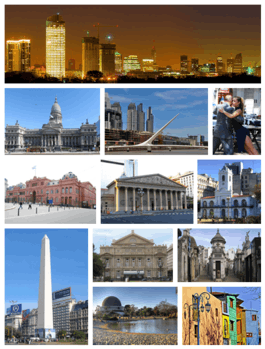
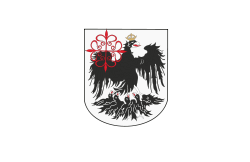


.jpg)







